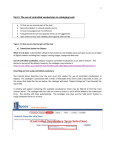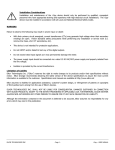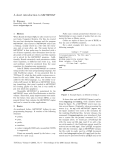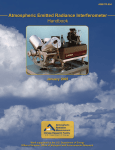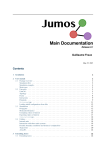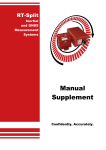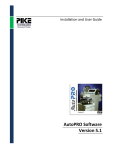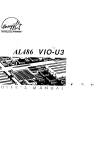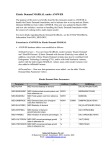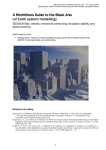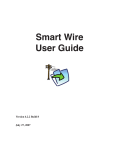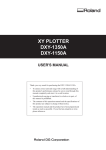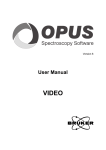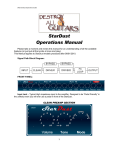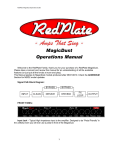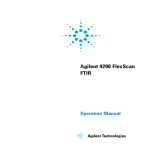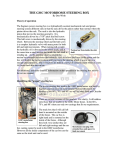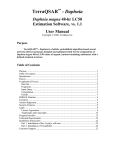Download IRUG JCAMP Paper
Transcript
Revised JCAMP-DX Spectral File Format for Submissions to the Infrared & Raman Users Group (IRUG) Spectral Database Beth A. Price, Philadelphia Museum of Art Boris Pretzel, Victoria & Albert Museum Suzanne Quillen Lomax, National Gallery of Art Charles Davis, Dow Chemical Company Janice H. Carlson, Winterthur Museum, Garden & Library1 26 September 2013 Version Abstract Revised guidelines are presented for the submission of both Raman and infrared (IR) spectra in the JCAMP-DX format to the Infrared and Raman Users Group (IRUG) Spectral Database. The previous guidelines were specific to IR spectra. IRUG uses JCAMP-DX files as the principal source of information for submitted spectra. It remains the chosen file format because it is platform independent, non-proprietary and allows error-free transfer of spectral information between various instruments and users. All information pertaining to a sample and spectrum (as outlined on the IRUG Spectrum Submission Form) is incorporated into the JCAMP-DX file in a consistent format to create a self-contained, complete data record. This format, consisting of JCAMP-DX 5.01 and IRUG defined labeled-data-records (LDRs) and text fields, is described. The LDRs for IRUG have been kept to a minimum to facilitate automatic transfer of information when IRUG JCAMP-DX files are imported into user local IR and Raman software packages. 1. Introduction The use of Raman spectroscopy in the study of cultural heritage has increased in recent years. Accordingly, revised guidelines have been developed to facilitate the submission of Raman spectra to the Infrared and Raman Users Group (IRUG) Spectral Database. The previous guidelines that were published by IRUG were specific to the submission of infrared (IR) spectra, whereas the specifications presented in this paper apply to both Raman and IR spectra.2 IRUG utilizes the non-proprietary JCAMP-DX, ASCII encoding protocol for all spectra that are submitted to its spectral database.3 The JCAMP-DX format is platform independent and allows for error-free transfer of spectral information between different instruments and users. JCAMP-DX files also are compatible to varying degrees with most commercial IR and Raman software and can be read and edited using standard text editors, such as WordPad® and Notepad®. A JCAMP-DX spectral file accommodates descriptive information including a spectrum’s title, JCAMP version, data type and origin, as well as instrumental, sample, and data details. The JCAMPDX standard is extensible and has enabled IRUG to develop its own customized IRUG JCAMP-DX file format that consistently incorporates all information for a sample, creating a discrete data 1 record. This customized file format implements both JCAMP-DX 5.01 and IRUG (user) defined labeled-data-records (LDRs) as described below. The file formatting and submission processes detailed in this paper will be automated on the IRUG website (www.irug.org) in 4th quarter 2012, when redevelopment of the website is completed.4 2. IRUG JCAMP-DX File Format and Content Labeled-Data-Records (LDRs) IRUG spectra are ASCII text files containing a series of linked labeled-data records (LDRs) compliant with the JCAMP-DX protocol. Each LDR begins with a data-label, or “LDR name”, followed by corresponding fields or data-sets comprising, respectively, text information and data on one or more lines (i.e., DATA-LABEL=[field]; [field]; or DATA-LABEL=[data-set]). The various data-labels and fields used and their definitions are found in the Table of Guidelines for IRUG JCAMP-DX Files and alphabetical and numerical Key to Fields for IRUG JCAMP-DX Spectral Files, as shown in Attachments 1 and 2a-b. For the sake of convenience, the data-labels listed in the Guidelines are grouped into categories: 1) header information, 2) originating institution details, 3) instrument details, 4) sampling details, 5) sample details, 6) additional sample details defined by IRUG, and 7) spectral parameters and tabular data. All LDRs begin with data-labels that are flagged by either “##” or “##$: IRUG-Defined Data Labels ##$LICENSE= ##$INSTITUTION FILE NAME= ##$STRUCTFORM= ##$LITERATURE REFERENCE= ##$OTHER ANALYTICAL METHODS= ##$SAMPLE SOURCE 1= ##$SOURCE LOCATION 1= ##$SAMPLE IDENTIFIER 1= ##$SAMPLE SOURCE 2= ##$SOURCE LOCATION 2= ##$SAMPLE IDENTIFIER 2= ##$SAMPLE SOURCE 3= ##$SOURCE LOCATION 3= ##$SAMPLE IDENTIFIER 3= ##$COLOR= ##$AGE= ##$IRUG MATERIAL CLASS= ##$OTHER= “##” signifies data-labels that are defined by the JCAMPDX protocol. In contrast, “##$” designates data-labels that were developed by IRUG. The information contained within these particular LDRs is relevant for the study and identification of cultural heritage materials. Examples of IRUG-defined data-labels include age, color and sample source location. There are a total of 18 IRUG-defined “##$” data-labels in each IRUG spectral file, as listed at left. 2 JCAMP-Defined Data Labels ##TITLE= ##JCAMP-DX= ##DATA TYPE= ##APPLICATION= ##ORIGIN= ##OWNER= ##DATE= ##LONGDATE= ##TIME= ##SPECTROMETER/DATA SYSTEM= ##INSTRUMENT PARAMETERS= ##RESOLUTION= ##DATA PROCESSING= ##SAMPLE DESCRIPTION= ##SAMPLING PROCEDURE= ##PATHLENGTH= ##PRESSURE= ##TEMPERATURE= ##CAS NAME= ##NAMES= ##MOLFORM= ##CAS REGISTRY NO= ##WISWESSER= ##BEILSTEIN LAWSON NO= ##MP= ##BP= ##REFRACTIVE INDEX= ##DENSITY= ##MW= ##CONCENTRATIONS= ##STATE= ##CROSS REFERENCE= ##DELTAX= ##XUNITS= ##YUNITS= ##FIRSTX= ##LASTX= ##FIRSTY= ##MAXX= ##MINX= ##MAXY= ##MINY= ##XFACTOR= ##YFACTOR= ##NPOINTS= ##XYDATA= ##END= The 47 remaining data-labels in a file are JCAMP-defined “##”, as listed below. Order of LDRs For an IRUG spectral file to comply with the JCAMP-DX standard, the first three LDRs must be placed in the following order: ##TITLE=, ##JCAMP-DX=, and ##DATA TYPE=. The final LDR in the file must be ##END=. The order of the remaining LDRs is not critical since JCAMP converters supplied with instrument vendors’ software may order them differently when translating a proprietary (native) spectral file into the JCAMP-DX format. However, IRUG groups the LDRs in its files in a specific order for better readability. This order is shown in Attachment 4, General Format for Infrared IRUG JCAMP-DX Spectral Files and Attachment 6, General Format for Raman IRUG JCAMP-DX Spectral Files. File Iterations The first iteration of a JCAMP-DX file is known as the raw spectral file as depicted in the work flow diagram below. It typically is created by a submitter using the JCAMP convertor supplied in her/his local instrument software to translate a native spectral file from its proprietary format into the JCAMP format. As a rule, some but not all of the LDRs required by the JCAMP-DX protocol are inserted into the raw file when it is translated by using a local converter. Since most of the raw files submitted to IRUG lack required LDRs, they are not considered JCAMP-DX compliant and must be edited. To mitigate this problem, the missing LDRs and associated information are collected by IRUG and inserted into the raw file. To accomplish this, a submitter must complete the IRUG Spectrum Submission Form shown in Attachment 3, to accompany the raw file for peer-review (QC). IRUG then collects the missing information from the form, formats and augments the submitter’s raw file to produce a JCAMP-DX spectral file meeting the IRUG standard. Example spectra are found in Attachment 6, Comparison of Raw JCAMP-DX vs. IRUG JCAMP.DX Spectral Files. 3 Spectral File Iterations in Submission Process Limit on Characters per Line All lines in an IRUG JCAMP-DX file, including the data-label, must not exceed 80 characters to prevent the truncation of lines. Although technology has improved since the line limit was established in 1985, this limit remains in the JCAMP-DX 5.01 protocol. Failure to observe it may cause data importation errors and files to not open properly. Except for the title line, where necessary entries may wrap over multiple lines. Title Line Format Only one line is allowed for the ##TITLE in a JCAMP-DX file and entries cannot be wrapped to the next line. In an IRUG file, 17 of the 80 characters are reserved for the data-label ##TITLE=, IRUG file name and a space. 10 or more additional characters are allotted for the originating institution acronym and mode, leaving a maximum of 53 characters to convey a sample’s name(s), source and identifier. For consistency in appearance, the title line is formatted as follows: IRUG filename followed by a space, then the sample/ trade/chemical name(s) with an initial capital letter and remaining entries in lower case (except for proper names and institution acronyms). This title line format, with an example, is shown in the box below. 4 IRUG JCAMP-DX Title Line Format ##TITLE=[IRUG filename] [common/trade/chemical name(s)]; [sample source 1-3]; [sample location 1-3]; [sample identifier 1-3]; [originating institution acronym]; mode Example Title LDR ##TITLE=IMP00414 Indigirite; Sarylakh Deposit, Yakutia, RU; BM1974521; NHM; tran All field entries in an IRUG file are separated by semi-colons with the exception of the submitter name and submitter institution name, which are combined. Apart from title entries, the IRUG website software will format all other LDRs, fields and associated information and data to produce a spectrum compliant with the IRUG JCAMP-DX standard. Optional LDRs Some LDRs are optional as data for them may not be applicable or available. For example, ##TEMPERATURE= is required only if different from room temperature. Any information supplied by the submitter (or subsequently by reviewers and senior editors) will be added to these fields where appropriate. Duplicate Information In some cases, fields appear in more than one LDR (information is repeated) to comply with the JCAMP-DX definitions and requirements. For example, “mode” appears in the two LDRs that begin with ##SAMPLE DESCRIPTION= and ##SAMPLING PROCEDURE=. Internationalization IRUG considers IRUG JCAMP-DX spectral files to be English language documents. As such, in accordance with IUPAC and ISO guidelines, the decimal point (that is, point on a line, not a comma) is used as the decimal separator.5 3. Submitting a Spectral File Using the IRUG Website Software at www.irug.org Directions for submitting a spectrum to the IRUG Spectral Database are found online in the IRUG.org User Manual.6 N.B.: To minimize compatibility issues between different instrument software, all raw JCAMP-DX files should be submitted to IRUG in the absorbance format. The general procedure is as follows: • Set up an account by clicking “Register” on www.irug.org homepage to make an IRUG username and password. Once your IRUG Regional Chair has enabled your account, you will have the ability to access the submission features of the website. • Convert your proprietary IR (absorbance format) or RAMAN file into a raw JCAMP-DX file using the JCAMP converter (version 4.24 or 5.01) supplied with your instrument or other software. Once 5 converted, open the raw JCAMP-DX file with Notepad® or WordPad® to confirm general text formatting. • Review the IR or Raman IRUG Spectrum Submission Form and Alphabetical and Numerical Keys (see Attachments 3, and 2a-b). Prepare the information requested on the form. Try to be as complete as possible. Much of this information will not appear in your raw JCAMP-DX file, so you must upload it with your submission. • Log in to www.irug.org with your username and password and click “My Account.” This will bring you to the “Submit Spectra” tab under “Spectral Database.” Choose either “Upload JCAMP-DX Spectral Files - Infrared”, or “Upload JCAMP-DX Spectral Files – Raman”. • Select the raw JCAMP-DX file(s) you wish to upload (use Browse option, select file(s), click Open). The names of the selected files will appear on your workspace. • Click “Upload” to begin uploading your files to the website (or “Cancel” to clear files). Files that have uploaded successfully will appear as thumbnail(s) on your workspace. If your files do not conform to JCAMP-DX 4.24 or 5.01, the system will return an error notice • Once your files show as thumbnails, click “Go to Manage & Submit Spectra” to continue the submission process. • In the “Manage & Submit Spectra List”, click on “New” tab to locate your newly uploaded files. IRUG assigns a “Tracking ID #” to your submission. • Click “Options”; select “Fill Out/Edit Form”. Provide as much information as possible, completing all fields signified with a red asterisk as “required”. You also can click “Apply template data to this spectrum form?” to apply a template with prefilled details to the submission form. • Once you have completed the form to your satisfaction, click “Save & Submit Spectrum for Review.” The following message will confirm submission: “Your spectrum has been sent for review. Thank you!” If you wish to submit the file at a later time, click “Save Draft & Continue.” Also in “Manage & Submit Spectra” you can perform batch actions to apply templates or submit groups of files. • You can access and check the status of your files by clicking “Manage & Submit Spectra” under the “Submit Spectra” tab and selecting the “New”, “Pending” “Submitted, “Returned” and “Published” tabs, respectively. • Submitted files are sent electronically to two or more independent reviewers for evaluation and comment, and to senior editors for final consideration and action. At the end of the review process, the file is either accepted for inclusion in the IRUG Spectral Database or returned to you with reviewers’ comments, perhaps with queries about the spectrum or asking for additional information. If the spectrum is returned with a request to resubmit, please try to resubmit the file. IRUG relies on your contributions for the success of the database! Once you have met the minimum terms for IRUG contributor status (10 or more accepted spectra), you are eligible to download the full IRUG Spectral Database as one ZIP file and periodic updates from www.irug.org. You also may request a printed copy of the latest edition (if available) and accompanying CD for a modest fee to cover production and shipping costs. Please 6 note that to receive the database, you must agree to the terms of the IRUG User License Agreement. This includes a provision that you must cite contributors and their institutions, the IRUG database and spectra when displaying or using them as references in publications and presentations. Example citation formats are given below. It is important to acknowledge colleagues for their generous contributions to the database.7 Example Citations for IRUG Spectra and Database Individual Spectrum Peggie, David, and The National Gallery, London. "INR00361, Baltic Amber." Infrared and Raman Users Group Spectral Database. Ed. Beth Price and Boris Pretzel. 2007 ed. Vol. 1. Philadelphia: Infrared and Raman Users Group, 2009. NR361. Entire Database Price, Beth, and Boris Pretzel, eds. Infrared and Raman Users Group Spectral Database. 2007 ed. Vol. 2. Philadelphia: Infrared and Raman Users Group, 2009. Also note that by contributing spectra to IRUG you explicitly accept the terms of the IRUG Contributor License Agreement. This means that copyright of your spectra remains with you and your institution but that you grant IRUG a free, worldwide and perpetual right to format, compile, and distribute your spectra as part of the IRUG database to other contributors and bodies deemed appropriate by the IRUG Board of Directors. 4. Using IRUG JCAMP-DX Spectral Files The published IRUG Spectral Database comprises two data types—IR and Raman—each with 11 directories, one for each of the IRUG Material Classes, containing uniquely numbered JCAMPDX files. The 11 directories/material classes are: carbohydrates and polysaccharides (CB); glasses (GL); minerals/pigments, and corrosion products (MP); mixtures (MX); natural resins (NR); oils/fats (OF); organic pigments and dyes (OD); proteinaceous materials (PR); synthetic resins (SR); unclassified materials (UC); and waxes (WX). When you receive the IRUG Database please back the JCAMP DX files up in a secure location as they can be overwritten. Please note that as distributed, the database is not a searchable library. The software for your instrument, however, can be used to create local libraries with the IRUG files for search and review. You may need to load the files by similar range values or other constraints as defined by your instrument vendor’s software (not as a consequence of IRUG’s files) but the value of such a local searchable IRUG library cannot be overestimated. Since IRUG JCAMP-DX spectral files are plain text files you also can use Notepad® or WordPad® to open and browse through them to access the spectral and descriptive information that is incorporated. 8 5. Summary 7 To accommodate the inclusion of Raman spectra to the IRUG Spectral Database, the IRUG JCAMP-DX format used for IR spectral files has been adapted. As with the IR files, the Raman file format incorporates both JCAMP-DX 4.24/5.01 and IRUG defined labeled-data-records (LDRs) to capture the descriptive information requested for spectral submissions. Twenty-two Raman specific fields have been implemented. The use of the LDRs and fields ensures that the final assembled IRUG JCAMP-DX Raman file is a self-contained, complete data record of high quality. The IRUG Spectral Database is an ongoing collaboration. IRUG released two peer-reviewed spectral database editions in 2000 and 2007, based on the described IR file format. The database now contains over 2,100 IR spectra donated by more than 100 international institutions and is a primary reference for the cultural heritage community. The addition of Raman spectra to the database will greatly expand its scope and enhance its utility. The IRUG website submission and supporting software currently are under development via a National Leadership Grant from the Institute of Museum and Library Services (IMLS).9 When the new website is launched, Raman spectra will be submitted on-line. In the interim, the IRUG Regional Chairs and Raman Committee Chair will work with potential contributors to facilitate the submission process. The chairs will assist contributors by uploading their Raman and IR spectra (absorbance format) with accompanying Submission Forms into a secure account. After the website launch, submitters will be able to complete the submission process online and their spectra will peer-reviewed with the new website software. Interested participants should contact one of the chairs listed on the website: Americas: Beth Price ([email protected]), Asia and Australia: Marcello Picollo ([email protected]), Europe and Africa: Boris Pretzel ([email protected]), or Raman Committee: Suzanne Lomax, ([email protected]). Go to www.irug.org for additional contact details. Feedback is welcomed. 1. J. H. C., deceased May 2006, contributed substantively to the development of the IRUG IR spectral file formatting protocol. 2. For previous guidelines, Pretzel, Boris, Beth A. Price, and Janice H. Carlson. "JCAMP-DX Spectral File Format for Submissions to the Infrared & Raman Users Group (IRUG) Database: 24 August 2008 Update." Infrared and Raman Users Group Spectral Database. 2007 ed. Vol. 1. Philadelphia: Infrared and Raman Users Group, 2009. 3. JCAMP is the acronym for “The Joint Committee on Atomic and Molecular Physical Data-Data Exchange”. For specifications, see: McDonald, Robert S., and Paul A. Wilks. "JCAMP-DX: A Standard Form for Exchange of Infrared Spectra in Computer Readable Form." Applied Spectroscopy 42.1 (1988): 15162.; Grasselli, J. G. "JCAMP-DX, a Standard Format for Exchange of Infrared Spectra in Computer Readable Form (Recommendations 1991)." Pure and Applied Chemistry 63.12 (1991): 1781-792.; McDonald, Robert S. "JCAMP-DX Definition of Terms." IUPAC.org. The Joint Committee on Atomic and Molecular Physical Data, 17 Dec. 1998. Web 20 Nov. 2009. http://www.jcamp-dx.org/; and Lampen, P., J. Lambert, R. J. Lancashire, R. S. McDonald, P. S. McIntyre, D. N. Rutledge, T. Fröhlich, and A. N. Davies. "An Extension to the JCAMP-DX Standard File Format, JCAMP-DX V.5.01." Pure and Applied Chemistry 71.8 (1999): 1549-556. 4. "IRUG Home." IRUG Home. Infrared and Raman Users Group (IRUG), Web. 15 July 2012. <http://www.irug.org/>. 5. See "Guidelines for Drafting Technical Reports and Recommendations." IUPAC.com. International Union of Pure and Applied Chemistry, 2007. Web. 31 Mar. 2011. <http://old.iupac.org/reports/provisional/guidelines.html>. 6. See B. Price, H. Dine, K. Sutherland, R. Vatankahah, A. Teller, L. Klein and M. Bearden. "IRUG.org Website User Manual Version 3.1." IRUG.org. Infrared and Raman Users Group, 26 Sep. 2013. <www.irug.org>. 7. The names of analysts and originating institutions can be accessed by opening IRUG files in a text editor, e.g. Notepad® or WordPad®. The general citation format for IRUG spectra is: [Analyst name (last name, first name)] and [Contributing institution name]. “[IRUG filename], [Common/trade/chemical name].” [Title of database]. Ed. [Editor(s) (first name, last name)]. [Edition]. [Volume]. [City of publication]: [Name of publisher], [Year of publication]. [Page(s)] 8. Do not resave the IRUG files from Word® as the proprietary coding will corrupt and render them useless. 9. The IMLS Advancing Digital Resources grant was awarded to the Philadelphia Museum of Art in partnership with IRUG in 2009. The IMLS mission is to inspire libraries and museums to advance innovation, lifelong learning, and cultural and civic engagement. It is the primary source of federal support for the 123,000 libraries and 17,500 museums in the United States. See <http://www.imls.gov/>. 8 Attachment 1 – Table of Guidelines for IRUG JCAMP-DX Spectral Files Numbers in brackets refer to terms (fields) defined in the Key to Fields for IRUG JCAMP-DX Spectral Files (Attachments 2a-b) 1 Data-Labels IR Fields Used by IRUG Section 1: Header Information Raman Fields Used by IRUG JCAMP-DX Definitions for Fields ##TITLE= IRUG filename (0); common name (39), trade name (40) or chemical name (41); sample source 1, 2 or 3 (58, 61 or 64); source location 1, 2 or 3 (59, 62 or 65); sample identifier 1, 2 or 3 (60, 63 or 66); originating institution acronym (2); mode (31) JCAMP-DX version # and software version # (17) IRUG filename (0); common name (39), trade name (40) or chemical name (41); sample source 1, 2 or 3 (58, 61 or 64); sample identifier 1, 2 or 3 (60, 63 or 66); originating institution acronym (2); mode (31) Required as first LDR of each JCAMP-DX FILE. JCAMP-DX version # and software version # (17) (Note: 5.01 - to ensure year 2000 compliance; JCAMP-DX version # $$ software version #) INFRARED SPECTRUM data type (18) application (19) (Note: 5.01 – to ensure year 2000 compliance; JCAMP-DX version # $$ software version #) RAMAN SPECTRUM data type (18) application (19) Required immediately after ##TITLE= to show JCAMP-DX version number. Software version used to generate JCAMP-DX file should be added as a comment ($$) after the version number. ##JCAMP-DX= ##DATA TYPE= ##APPLICATION= Section 2: Originating Institution Details ##ORIGIN= ##OWNER= originating institution name (1); originating institution address (3); analyst(s) name(s) (4); analyst telephone (5); analyst fax (6); analyst email (7); submitter name (8), submitter institution name (9); submitter telephone (10); submitter fax (11); submitter email (12) originating institution name (1); originating institution address (3); analyst(s) name(s) (4); analyst telephone (5); analyst fax (6); analyst email (7); submitter name (8), submitter institution name (9); submitter telephone (10); submitter fax (11); submitter email (12) (Note: Use abbreviations (tel: ; fax: ; email: ;) and leave missing data sections blank. No semicolon between submitter name and submitter institution name, which comprise one field.) SPECTRUM COPYRIGHT (c) (year YYYY) BY originating institution name (1) (Note: Use abbreviations (tel: ; fax: ; email ;) and leave missing data sections blank. No semicolon between submitter name and submitter institution name, which comprise one field.) SPECTRUM COPYRIGHT (c) (year YYYY) BY originating institution name (1) DATABASE COPYRIGHT (c) (year YYYY) BY Infrared and Raman Users Group (IRUG) DATABASE COPYRIGHT (c) (year YYYY) BY Infrared and Raman Users Group (IRUG) (Note: “DATABASE COPYRIGHT” begins on separate line) (Note: “DATABASE COPYRIGHT” begins on separate line) Should contain concise description of contents suitable as the title for data plot Defines data technique for current JCAMP-DX BLOCK. Intended for a number of ##DATATYPE= names for a particular application. Organization name, address, name of individual analyst(s), telephone number, FAX number, E-mail address, as appropriate. This information is required; the originator of a JCAMP-DX file must see that it is included. The instrument manufacturer is not responsible for this information. Under no circumstances should a file be retransmitted without this information. Note: Omission of this information is not necessarily a valid reason for software to refuse to process a JCAMP-DX file. Name of owner of proprietary data. The organization or individual named under ##ORIGIN= is responsible for accuracy of this field. If the data is copyrighted, this line should read "COPYRIGHT (c) (year) BY (name)." This information is not optional; the originator of a JCAMP-DX file should always see that it is included. If ##OWNER= contains "PUBLIC DOMAIN", the implication is that the data may be copied without permission on the authority of whoever is named under ##ORIGIN=. However, absence of ##OWNER= does not imply permission to copy. 9 ##$LICENSE= By accepting this database user agrees to be bound by the terms of the IRUG user’s license. Any reference written/oral made to this file must include accreditation to BOTH the originating individual/institution and IRUG. Contributor agrees to be bound by the terms of the IRUG contributor’s license. By accepting this database user agrees to be bound by the terms of the IRUG user’s license. Any reference written/oral made to this file must include accreditation to BOTH the originating individual/institution and IRUG. Contributor agrees to be bound by the terms of the IRUG contributor’s license. IRUG defined data label, no pre-existing JCAMP definition. ##$INSTITUTION FILE NAME= ##DATE= originating institution filename (13) originating institution filename (13) IRUG defined data label - no pre-existing JCAMP definition YY/MM/DD date (14) YYYY/MM/DD longdate (15) HR:MIN:SEC time (16) YY/MM/DD date (14) YYYY/MM/DD longdate (15) HR:MIN:SEC time (16) Date spectrum measured/acquired in the form: YY/MM/DD (note order). Date spectrum measured/acquired in the form: YYYY/MM/DD, where YYYY is the year, MM is the month, DD is the day Time data measured/acquired in the form: HR:MIN:SEC (24-hour clock). HH:MM:SS:SSSS ±UUUU, where HH:MM are the hours and minutes in local time (optional), SS:SSSS are the seconds and fractional seconds (optional), UUUU is time zone difference to Universal Coordinated Time (UTC) (optional) spectrometer manufacturer and model (20); instrument software version and release (21); detector type (22); spectrometer class (71) apodization type (23); accumulations (74); instrument purge (25); spectral range (26); excitation source (72); power (73); calibration (75); data collection type (76); integration time (77); other detector parameters (78) resolution (27) Contains manufacturer's spectrometer name and model, software system name and release number, as appropriate, in form used by the manufacturer. ##LONGDATE ##TIME= Section 3: Instrument Details ##SPECTROMETER/DATA SYSTEM= ##INSTRUMENT PARAMETERS= spectrometer manufacturer and model (20); instrument software version and release (21); detector type (22); spectrometer class (71) apodization type (23); scans (24); instrument purge (25); spectral range (26) ##RESOLUTION= resolution (27) ##DATA PROCESSING= (Note: resolution of acquired spectrum, not of data in DX file) CO2 correction (28); baseline correction (29); other data processing (30) Section 4: Sampling Details ##SAMPLE DESCRIPTION= mode (31); accessories (32); sample support (33) (Note: resolution of acquired spectrum, not of data in DX file) baseline correction (29); fluorescence correction (79); cosmic ray removal (80); detector binning (81); other data processing (30) mode (31); accessories (32); sample support (33); objective magnification (82); numerical aperture (83); working distance (84); spot size (85); confocal (86); angle (87); polarization (88); 10 Optional field is a list of pertinent instrument settings using standard notation when available, otherwise using manufacturer’s notation. Only settings which are essential for applications should be included. Nominal resolution in units specified by ##XUNITS= as a single number for spectra at constant resolution throughout, or as pairs of the form :R1,X1,...,Rn,Xn, where R stands for resolution at abscissa X. Description of background correction, smoothing, subtraction, deconvolution procedures, apodization function, zero-fill, or other data processing, together with reference to original spectra used for subtractions. First entry in this field should be MODE of observation (transmission, specular reflection, PAS, matrix isolation, etc., for spectra Name and model of appropriate accessories, cell thickness, and window material for fixed liquid cells, ATR plate material, angle and cone of incidence, and effective number of reflections for ATR measurements, polarization, and special modulation techniques, as discussed by, Grasselli, Jeanette G., Peter R. Griffiths, and Robert W. Hannah. "Criteria for Presentation of Spectra from Computerized IR Instruments." Applied Spectroscopy 36 (1982): 87-91, are appropriate ##SAMPLING PROCEDURE= ##PATH LENGTH= ##PRESSURE= ##TEMPERATURE= mode (31); sample preparation (34) pathlength (35), where applicable pressure (36), where significantly different from atmospheric temperature (37), where significantly different from room temperature filters (89); cut-off frequency (90); grating type (91); grating density (92); laser defocus (93) mode (31); sample preparation (34); orientation (95) pathlength (35), where applicable pressure (36), where significantly different from atmospheric temperature (37), where significantly different from room temperature for other types of measurement. First entry in this field should be MODE of observation (e.g., transmission, specular reflection). Use enough space to describe the procedure. Give citation to a description of a standard procedure. Pathlength in cm. Sample pressure in appropriate units, if significantly different from atmospheric. Sample temperature in degrees C, if significantly different from room temperature. Section 5: Sample Details ##CAS NAME= CAS name (38), where available CAS name (38), where available ##NAMES= common name (39); trade name (40); chemical name (41) common name (39); trade name (40); chemical name (41) (Note: Each name placed on separate line) molecular formula (42), where available (Note: Each name placed on separate line) molecular formula (42), where available ##MOLFORM= Name according to Chemical Abstracts naming conventions as described in Appendix IV of the 1985 CAS Index Guide. Examples can be found in Chemical Abstracts indices or the Merck Index. Greek Letters are spelled out, and standard ASCII capitals are used for small capitals. Sub/Superscripts are indicated by prefixes / and ^, respectively. Example, alpha-D-glucopyranose, 1-(dihydrogen phosphate). Common, trade/brand or other names. Multiple names placed on separate lines, i.e., each name placed on separate lines. Molecular formula. Elemental symbols are arranged: carbon, hydrogen, and then remaining element symbols in alphabetic order. The first letter of each elemental symbol is capitalized. The second letter, if required, is lower case. One-letter symbols must be separated from adjacent symbols by a blank or digit. Sub/super scripts are terminated by the next non-digit. Slash may be omitted for subscripts. For readability, each atomic symbol may be separated from its predecessor by a space. For substances which are represented by dotdisconnected formulas (hydrates, etc.), each fragment is represented in the above order, and the dot is represented by *. ##$STRUCTFORM= ##CAS REGISTRY No= structural formula (43), where available CAS registry no (44), where available structural formula (43), where available CAS registry no (44), where available ##WISWESSER= Wiswesser line notation (45), where available Wiswesser line notation (45), where available 11 Isotopic mass is specified by a leading superscript. D and T may be used for deuterium and tritium, respectively. Examples: C2H4O2 or C2 H4 O2 (Acetic acid) C6 H9 Cr O6 * H2 O (Chromic acetate monohydrate) H2^17O (water, mass 17 oxygen) IRUG defined data label - no pre-existing JCAMP definition CAS Registry Numbers for many compounds can be found in Chemical Abstracts indices, Merck Index, or CAS ON-LINE. The Wiswesser line notation is a precise, concise means of expressing structural formulas as character strings. The basic idea is to use letter symbols to denote functional groups and numbers to express the lengths of chains and the sizes of rings. ##BEILSTEIN LAWSON No= Beilstein Lawson no (46), where available Beilstein Lawson no (46), where available For details see: Smith, E. G. The Wiswesser-Line Formula Chemical Notation. 2nd ed. New York: McGraw-Hill, 1968; and Smith, E. G. and Baker. P. A. The Wiswesser Line-Formula Chemical Notation. 3rd ed. Cherry Hill, NJ: Chemical Information Management, Inc., 1975. The Beilstein Lawson Number is a structural formula clustering code based on the Beilstein System. It is used for locating information in Beilstein databases, including the STN on-line database. The code contains only structural information and can be generated locally on microcomputers from connection table data alone. ##MP= ##BP= MP (47), where available BP (48), where available MP (47), where available BP (48), where available ##REFRACTIVE INDEX= ##DENSITY= ##MW= ##CONCENTRATIONS= refractive index (49), where available density (50), where available MW (51), where available concentrations (52), where available. Include known impurities refractive index (49), where available density (50), where available MW (51), where available concentrations (52), where available. Include known impurities For a simple description of the algorithm see: Lawson, Alexander J. "Structure Graphics in Pointers to Beilstein Out.” Graphics for Chemical Structures: Integration of Text and Data. Ed. Wendy Warr. ACS Symposium Series 341, Washington, DC: American Chemical Society, 1987. 80-87. Melting point in degrees C. Boiling point in degrees C, followed by pressure in mm Hg if other than one atmosphere. In the form: ND = 1542^20 (index at 20 degrees C for NaD line). Density in g/cc. Molecular weight in grams/mol List of known components, impurities and their concentrations in the following form, where N stands for name (enclosed in angle brackets if more than one word); C, for concentration; and U, for units of concentration: Example: ##CONCENTRATIONS=(NCU) (N1, C1, U1), (N2, C2, U2), etc. (Note: Each group starts a new line and may continue on the following lines.) state (53); form (54) (Note: Each group starts a new line and may continue on the following lines.) state (53); form (54) ##CROSS REFERENCE= cross reference to additional spectra (55) cross reference to additional spectra (55) ##$LITERATURE REFERENCE= literature reference (56) literature reference (56) Form: solution, KBr pellet, powder, Nujol mull, etc. (Note: For IRUG, sample prep is under ##SAMPLING PROCEDURE) Cross references refer to additional/related spectral data on the same sample, e.g., different thickness, mulling agent, polarization, temperature, time, or serve to link a peak table or interferogram with a spectrum IRUG defined data label - no pre-existing JCAMP definition (Note: Literature citing spectrum or details of the spectrum or information about the material.) Other analytical methods (57) (Note: Literature citing spectrum or details of the spectrum or information about the material.) Other analytical methods (57) IRUG defined data label - no pre-existing JCAMP definition (Note: Supplemental methods used to analyze sample) (Note: Supplemental methods used to analyze sample) ##STATE= ##$OTHER ANALYTICAL METHODS= Section 6: Additional sample details defined by IRUG ##$SAMPLE SOURCE 1 ##$SOURCE LOCATION 1 sample source 1 (58) source location 1 (59) sample source 1 (58) source location 1 (59) 12 The group for each component is enclosed in parentheses. Each group starts a new line and may continue on the following lines. Physical state: Solid, liquid, or gas IRUG defined data label - no pre-existing JCAMP definition IRUG defined data label - no pre-existing JCAMP definition ##$SAMPLE IDENTIFIER 1 ##$SAMPLE SOURCE 2 ##$SOURCE LOCATION 2 ##$SAMPLE IDENTIFIER 2 ##$SAMPLE SOURCE 3 ##$SOURCE LOCATION 3 ##$SAMPLE IDENTIFIER 3 ##$COLOR= ##$AGE= ##$IRUG MATERIAL CLASS= ##$OTHER= ##= sample identifier 1 (60) sample identifier 1 (60) IRUG defined data label - no pre-existing JCAMP definition sample source 2 (61) source location 2 (62) sample identifier 2 (63) sample source 2 (61) source location 2 (62) sample identifier 2 (63) IRUG defined data label - no pre-existing JCAMP definition IRUG defined data label - no pre-existing JCAMP definition IRUG defined data label - no pre-existing JCAMP definition sample source 3 (64) source location 3 (65) sample identifier 3 (66) sample source 3 (64) source location 3 (65) sample identifier 3 (66) IRUG defined data label - no pre-existing JCAMP definition IRUG defined data label - no pre-existing JCAMP definition IRUG defined data label - no pre-existing JCAMP definition color (67) age (68) color (67) age (68) IRUG defined data label - no pre-existing JCAMP definition IRUG defined data label - no pre-existing JCAMP definition (Note: age of sample in years or date (YYYY/MM/DD or YYYY) of acquisition, manufacture or synthesis, if known) IRUG material class (69) (Note: age of sample in years or date (YYYY/MM/DD or YYYY) of acquisition, manufacture or synthesis, if known) IRUG material class (69) IRUG defined data label - no pre-existing JCAMP definition sample type (70); other (94) sample type (70); other (94) IRUG defined data label - no pre-existing JCAMP definition Note: Other (94) is extra IRUG field for miscellaneous information that does not fit into other fields Any additional information Note: Other (94) is extra IRUG field for miscellaneous information that does not fit into other fields Any additional information Comments may be introduced by a DATA-LABEL-FLAG (##) plus a DATALABEL-TERMINATOR (=), with null DATA-LABEL-NAME. Such ##= comments may continue for more than one line, terminating at the next DATA-LABEL-FLAG. Sub-headings (not JCAMP-DX Labels) may be used within such comments at the discretion of the end-user. As many such comments as needed may be included between ##TITLE= and ##END=. Section 7: Spectral Parameters and Tabular Data ##DELTAX= Automatically inserted by commercial software converter Automatically inserted by commercial software converter ##XUNITS= Automatically inserted by commercial software converter, 1/cm preferred Automatically inserted by commercial software converter, 1/cm preferred ##YUNITS= ##XFACTOR= ##YFACTOR= ##FIRSTX= Automatically inserted by commercial software converter: absorbance / transmittance /arbitrary units... For maximum compatibility, IR spectra for submission to IRUG should be in ABSORBANCE. Automatically inserted by commercial software converter: arbitrary units... For Raman, this should be RELATIVE INTENSITY. Automatically inserted by commercial software converter Automatically inserted by commercial software converter Automatically inserted by commercial software converter Automatically inserted by commercial software converter Automatically inserted by commercial software Automatically inserted by commercial software 13 Gives the nominal spacing between points for informing the user. Actual X-values should be calculated from (##LASTX= minus ##FIRSTX=)/(##NPOINTS= minus 1). Gives the abscissa units for the current DATA TYPE. Any standard unit is acceptable. For infrared spectra, the following units are appropriate: 1/CM (representing wavenumber), MICROMETERS, NANOMETERS, SECONDS, ARBITRARY UNITS Gives the ordinate units for the current DATA TYPE. Any standard units are acceptable. For infrared spectra, the following units are appropriate: TRANSMITTANCE, REFLECTANCE, ABSORBANCE, KUBELKA-MONK, or ARBITRARY UNITS. For Raman, RELATIVE INTENSITY. ##XFACTOR= and ##YFACTOR=, respectively, are factors by which components of tabulated abscissa and ordinate values (##XYDATA=) should be multiplied to obtain actual values. For ASCII representation, these factors should be chosen to convert tabulated values to integers, clipping off all but about 1 digit of noise on the average. ##FIRSTX= and ##LASTX= are the first and last ACTUAL abscissa values ##LASTX= ##NPOINTS= ##FIRSTY= ##MAXY= #MAXX= ##MINY= ##MINX= ##XYDATA= converter Automatically inserted by commercial software converter converter Automatically inserted by commercial software converter Automatically inserted by commercial software converter Automatically inserted by commercial software converter Automatically inserted by commercial software converter Automatically inserted by commercial software converter Automatically inserted by commercial software converter Automatically inserted by commercial software converter Automatically inserted by commercial software converter Automatically inserted by commercial software converter Automatically inserted by commercial software converter Automatically inserted by commercial software converter Automatically inserted by commercial software converter Automatically inserted by commercial software converter Automatically inserted by commercial software converter Automatically inserted by commercial software converter of ##XDATA=. First tabulated abscissa times ##XFACTOR= should equal ##FIRSTX=. Spectral data are tabulated in order of EITHER increasing or decreasing abscissa values. ##FIRSTX= specifies the abscissa corresponding to the first value listed under the current DATA TYPE, not the smallest abscissa Number of components of a data class, such as ##XYDATA=. ##FIRSTY= is the actual Y-value corresponding to ##FIRSTX=. ##FIRSTY= should equal ##YFACTOR= times the first Y-value in the current ##DATACLASS=. NOTE: If the ordinate value corresponding to ##FIRSTX= is undefined, i.e., represented by “?”, then ##FIRSTY= also is represented by “?”. This is the reason for recommending the different way of checking data scaling as outlined under ##MAXX=, etc. These attributes of the data array were listed as OPTIONAL in V4.24. It is currently recommended that ##MAXY= and ##MINY= be required for ##XYDATA=. It is now recommended that the difference ##MAXY= minus ##MINY= be compared to the difference between converted values to check ordinate scaling rather than comparing ##FIRSTY= to the product of ##YFACTOR= and the first converted ordinate as recommended in V4.24. See NOTE under ##FIRSTY= Heading for a data array which consists of a list of ordinates at equal X-intervals, as specified by the parameters found in: ##XUNITS=, ##YUNITS=, ##XFACTOR=, ##YFACTOR=, ##FIRSTX=, ##LASTX=, ##MAXY=, ##MINY=, ##NPOINTS=, ##FIRSTY=. The tabular form of the ##XYDATA= is a series of lines organized as follows: X1 Y1 Y2 Y3 Y4 Y5 … YN. ... Data automatically inserted by commercial software converter Section 1: Header Information, continued ##End= Automatically inserted by commercial software converter Data automatically inserted by commercial software converter Automatically inserted by commercial software converter 1 This form of data is represented symbolically by a VARIABLE LIST, as follows: ##XYDATA= (X++(Y..Y)), where X++ indicates that the first item in a line is an X-value, ++ indicates that X is incremented for each following Y-value and (Y..Y) indicates that the initial X-value is followed by a succession of Y-values Indicates the end of a JCAMP-DX file; file must end with ##END=<carriage return/line feed>. See McDonald, Robert S. and Paul A. Wilks, Jr. “JCAMP-DX: A Standard Form for Exchange for Infrared Spectra in Computer Readable Form.” Applied Spectroscopy 42 (1988): 151-162; Grasselli, Jeanette G. “JCAMP-DX, A Standard Format for Exchange of Infrared Spectra in Computer Readable Form: IUPAC Recommendations 1991.” Pure & Applied Chemistry 63 (1991): 1781-1792; McDonald, Robert S. “JCAMP-DX Definition of Terms.” 17 Dec. 1998. The Joint Committee on Atomic and Molecular Physical Data. 20 Nov. 2009 <http://members.aol.com/rmcdjcamp/defines.htm>; and Lampen, Peter, et al. “An Extension to the JCAMP-DX Standard File Format, JCAMP-DX V.5.01 (IUPAC Recommendations 1999).” Pure & Applied Chemistry 71 (1999): 1549-1556. 14 Attachment 2a – Key to Fields in IRUG JCAMP-DX Spectral Files (Alphabetical) • Accessories (32): name and model of accessories, such as ATR (attenuated total reflectance), BC (beam condenser), DRIFT (diffuse reflectance), FO (fiber optic probe), GA (grazing angle), MICR (microscope), SR (spectral reflectance), sample spinner, or other (specify). If accessory has different detector from spectrometer, specify. (Example 1: (MICR) microscope, Thermo Continuum, MCTA; Example 2: (MICR) microscope, Bruker Optics Senterra, CCD) • Accumulations (74): number of accumulations used (co-added) to produce spectrum. (Example: 10) • Age (68): approximate age of material given in years; year of acquisition, purchase, manufacture, or synthesis; aging history, if known. (Example 1: 50 years; Example 2: 20 years, at least; Example 3: 1990, acquired; Example 4: 1991, synthesized, 20 years, naturally aged; Example 5: unknown) • Analyst email (7): email address of analyst or laboratory or department where spectrum was generated. (Example: [email protected]) • Analyst fax (6): fax # of analyst or laboratory or department where spectrum was generated. (Example: + 1 617 369 3702) • Analyst telephone (5): telephone # of analyst or laboratory or department where spectrum was generated (Example: +1 617 267 3182) • Analyst(s) name(s) (4): name(s) of analyst(s) who acquired spectrum (Example: Richard Newman) • Angle (87): collecting angle of scattered radiation, in degrees (Example 1: 90 degrees, Example 2: 180 degrees backscattered) • Apodization type (23): mathematical technique used to reduce or remove side lobes. Apodization type includes, e.g., Boxcar, Happ-Genzel, Norton-Beer (weak, medium, strong), triangular, or none (Example: Norton-Beer weak) • Application (19): name for particular data type application, if used. [IR Example1: diffuse reflectance (DRIFT); IR Example 2: photoacoustic spectroscopy (PAS); Raman Example 1: surface enhanced Raman spectroscopy (SERS); Raman Example 2: resonance Raman (RR)] • Baseline correction (29): flattening of baseline, Y or N [fluorescence correction (70) is noted separately] • Beilstein Lawson no (46): structural formula clustering code based on Beilstein system. (Example: 142785) For specifics see: Lawson, Alexander J. "Structure Graphics In: Pointers to Beilstein Out." Graphics for Chemical Structures: Integration with Text and Data. Washington, DC: American Chemical Society, 1987. 80-87. • BP (48): boiling point in degrees C (Celsius) followed by pressure in mm Hg, if not one atmosphere. Designate as measured or literature with source, if known. Cite literature reference in the MLA (Modern Language Association) format. Go to http://easybib.com/ for open access formatting software. [Example 1: 64.7 degrees C, literature, The Merck Index 11th Ed., # 5868, Merck & Co., Inc., NJ, 1989, p. 939; Example 2: 34.8 degrees C at 60 mm Hg (measured)] • Calibration (75): standards used to calibrate system (wavelength/intensity), such as white light, tungstenhalogen, atomic line, single band silicon, single band diamond, multiband Neon, shott glass, other (specify), or none. (Example: shott glass and Ne lamp anchored to 4-acetamidophenol) • CAS name (38): Chemical Abstracts Service name. Name based on naming convention as described in Appendix IV of the 1985 CAS Index Guide. Greek Letters are spelled out, standard ASCII capitals are used for small capitals, superscripts are indicated by prefixes / and ^. Examples can be found in Chemical Abstracts indices or Merck Index. (Example CAS name for Toluidine Red: PR3: 1-[4-methyl-2-nitrophenylazo]-2-naphthol) • CAS registry no (44): Chemical Abstracts Service Registry number. Unique accession number assigned by the Chemical Abstracts Service division of the American Chemical Society. CAS Registry numbers are assigned to every uniquely identifiable substance, sequential and have no chemical significance. CAS Registry Numbers for many compounds can be found in Chemical Abstracts indices, Merck Index, or CAS On-Line. (Ex.: 1344-48-5) • Chemical name(s) (41): chemical/scientific name(s) for sample material. May include biological classification(s), such as genus and species. (Example 1: Mercuric sulfide; Example 2, multiple chemical names: methyl palmitate, palmitic acid methyl ester, hexadecanoic methyl ester) • CO2 correction (28): removal of spectral bands attributed to CO2, Y or N. (Example: N) 15 • Color (67): color of sample analyzed. (Example1: red; Example 2: blue, medium, opaque) • Common name(s) (39): common/generic name(s) for sample material. (Example 1: vermilion; Example 2: cinnabar) In IRUG JCAMP-DX files, multiple names are entered on separate lines. • Concentrations (52): list of names of known components and impurities, their concentrations, and units in the following format: name of each component, concentration and units. [Example: (N1, C1, U1), (N2, C2, U2), where N=name, C=concentration and U=units of concentration]. • Confocal (86): use of confocal optical arrangement. In format: Y or N. (Example: N) • Cosmic ray removal (80): filtering of spectral artifacts (spikes/peaks) in Raman spectrum produced by cosmic rays rather than Raman emissions. In format: Y or N. (Example: N) • Cross reference to additional spectra (55): cross reference to related spectra/data on same sample. Spectra acquired under different conditions, e.g., data type (Raman vs. IR), excitation source (1064 nm vs. 785 nm), accessory (diffuse reflectance vs. grazing angle), polarization (none vs. 45 degrees CCW), sample temperature (room vs. 50 degrees C). In each case, corresponding IRUG spectral filenames should be entered. • Cut-off frequency (90): low frequency cut-off in cm-1 (1/cm) (Example: 70 cm-1) • Data collection type (76): Raman acquisition mode, static or scanned (Example: scanned) • Data type (18): data type as INFRARED SPECTRUM or RAMAN SPECTRUM. • Date (14): date spectrum was measured/acquired in format: YY/MM/DD, where YY is year, MM is month, DD is day. (Example: 07/10/02) • Density (50): mass per unit volume expressed as grams per cubic centimeter (g/cc) at 20 degrees C (Celsius) (Example: 8.1 g/cc). • Detector binning (81): reduction of CCD associated noise by pixel addition or grouping. In format: Y or N. (Example: N) • Detector type (22): type of detector. [Examples: DTGS (deuterated tri-glycine sulfate), MCTA or B (mercury cadmium telluride), CCD (charge coupled device), CID (charge injection device), PDA (photo diode array), PMT (photomultiplier tube), Ge (germanium), InGaAs (indium gallium arsenide) or other (specify)] • Excitation source (72): excitation source (laser line) wavelength in nanometers (nm). (Example: 785 nm) • Filters (89): optical filters used to prevent stray light from reaching spectrometer/detector, such as edge (long or short pass), notch, or laser line. (Example 1: holographic notch; Example 2: dielectric edge) • Fluorescence correction (79): mathematical correction, such as subtracted shifted fluorescence removal, fluorescence subtraction, concave rubber band, or other, for broad fluorescence emission caused by Raman scattering close to an electronic transition. In format: Y or N. (Example: Y) • Form (54): form of sample analyzed, such as chunk, emulsion, flake, fiber, paste, powder, sheet, etc. (Example: powder) • Grating density (92): line density of grating in dispersive Raman instrument. In format: lines per mm (lines/mm). Typical values from 300 lines/mm (low resolution) to 1800 lines/mm (high resolution). (Example: 1200 lines/mm) • Grating type (91): type of grating: reflection, such as holographically recorded diffraction grating (HRDG), classically ruled mechanical grating (CRMG); or transmission, such as holographic or interference photosensitive film. (Example 1: reflection, ruled; Example 2: reflection, holographic) • Instrument purge (25): dry air/gas instrument purge used to minimize effects of CO2, water vapor in spectrum. In format: Y or N, name of purge gas (Example: Y, dry air) • Instrument software, version and release (21): instrument software and software version/release in format used by manufacturer (Example for IR: Thermo Nicolet, 6.0 a; Example for Raman: Bruker Opus 6.5) • Integration time (77): integration (dwell) time in seconds (sec) (Example: 50 sec) • IRUG filename (0): unique 8 character IRUG filename, beginning with “I” for infrared or “R” for Raman, followed by 2 letter acronym for IRUG material class and five digit # inserted by IRUG during publication of file. (IR Example for IRUG DB natural resin spectrum #603: INR00603.dx; Raman Example for IRUG DB mineral pigment #31: RMP00031) • IRUG material class (69): general category used by IRUG to classify (type) a spectrum. There are 11 Material Classes: carbohydrates (CB); glasses (GL); minerals, pigments, and corrosion products (MP); mixtures (MX); 16 natural resins (NR); oils and fats (OF); organic pigments and dyes (OD); proteins (PR); synthetic resins (SR); unclassified materials (UC); and waxes (WX). (Example: ##$IRUG MATERIALS CLASS=MP) • JCAMP-DX version # and software version # (17): JCAMP-DX version number and software version number used by the submitter to create JCAMP-DX file (Example: JCAMP-DX 5.01 $$ Nicolet v. 5.21) • Laser defocus (93): defocusing of laser. In format: Y or N (FT Raman only) • Literature reference (56): reference to literature citing spectrum or spectrum details or information about sample material. To be cited in the MLA (Modern Language Association) format. Go to http://easybib.com/ for open access formatting software. (Example 1: Frost, R. J., Wayde N. Martens, and Theo, J. Kloprogge. "Raman Spectroscopic Study of Cinnabar (HgS), Realgar (As4S4), and Orpiment (As2S3) at 298 and 77K." Neues Jahrbuch Fuer Mineralogie, Monatshefte 10 (2002): 469-80.) • Longdate (15): date spectrum measured/acquired in format: YYYY/MM/DD, where YYYY is year, MM is month, DD is day. (Example: 2007/10/02) • Mode (31): data collection mode: tran (transmission) or refl (reflectance) for IR, scat (scatter) for Raman. • Molecular formula (42): molecular formula for a sample substance consistent with the relative molecular mass. Element arrangement: C, H, then remaining elements in alphabetical order with spaces after each single element and * for dots. First letter of each symbol is capitalized; second letter is lower case. Sub and superscripts terminated by the next non-digit. For dot-disconnected formulas (hydrates, etc.), fragments are represented in above order with dot represented by *. Isotopic mass specified by a leading superscript. D and T may be used for deuterium and tritium, respectively. (Example 1, calcium carbonate: C Ca O3; Example 2, gypsum: Ca O4 S * H4 O2; Example 3, acetic acid: C2H4O2 or C2 H4 O2; Example 4, chromic acetate monohydrate: C6 H9 Cr O6 * H2 O; Example 5, water, mass 17 oxygen: H2^17O) • MP (47): melting point in degrees C (Celsius) designated as measured or literature; assumed to be at standard pressure unless otherwise indicated. Cite literature reference in the MLA (Modern Language Association) format. Go to http://easybib.com/ for open access formatting software. (Example: 210 degrees C, measured) • MW (51): molecular weight (unitless relative molecular mass). (Example: 232.655) • Numerical aperture (83): numerical aperture of collecting lens (Example: 0.75) • Objective magnification (82): collecting lens magnification (Example: 50x) • Orientation (95): orientation of sample (a, b, c, alpha, beta, gamma) • Originating institution acronym (2): acronym for institution where spectrum was generated. (Example: MFAB) • Originating institution address (3): full address for institution where spectrum was generated. (Example: 465 Huntington Avenue, Boston, MA, 02115, US) • Originating institution filename (13): spectrum filename as assigned by originating institution. (Ex: redlead1.dx) • Originating institution name (1): full name of institution where spectrum was generated. (Example: Museum of Fine Arts Boston) • Other (94): extra IRUG field for miscellaneous information or future use. (Example: Translated from Renishaw WiRE 2.0 format to raw JCAMP-DX with Thermo Nicolet Omnic 6.0) • Other analytical methods (57): supplemental methods used to analyze sample, such as: AA (atomic absorption), AES (Auger electron spectroscopy), EDS (energy dispersive spectroscopy), EPMA (electron probe microanalysis), FLM (fluorescence light microscopy), Fourier transform Infrared Spectroscopy (FTIR), FT-Raman (Fourier transform Raman spectroscopy), GC (gas chromatography), GC-IR (gas chromatography –infrared spectroscopy), GC-MS (gas chromatography mass spectrometry), ICP (inductively coupled plasma analysis) , ICP-MS (Inductively coupled plasma mass spectrometry), LC-MS (liquid chromatography mass spectrometry), PAGE, PLM (polarized light microscopy), Py-GCMS (pyrolysis gas chromatography mass spectrometry), Raman, RP-HPLC (reverse phase high performance liquid chromatography), SEM (scanning electron microscopy), SERS (surface enhanced Raman spectroscopy), SIMS (secondary ion mass spectrometry), TLC (thin layer chromatography), VLM (visible light microscopy), XANES (X-ray absorption near edge structure analysis), XRD (x-ray diffraction), XRF (x-ray fluorescence), or other (specify). (Example: SEM-EDS) • Other data processing (30): data manipulation such as spectral subtraction, smoothing, deconvolution, transformations, and others (not baseline, CO2, fluorescence, and cosmic ray removal). (Example 1: KramersKronig transformation; Example 2: none) 17 • Other detector parameters (78): other detector parameters. • Pathlength (35): pathlength in centimeters (cm). • Polarization (88): Y or N for polarization of incident/excitation radiation with degrees and orientation followed by Y or N for polarization of scattered radiation with degrees and orientation (Example: incident, Y, 45 degrees CCW, scattered, N) • Power (73): power incident on sample (not of source) in milliwatts (mW) (Example: 18.7 mW) • Pressure (36): sample pressure during data acquisition, if significantly different from atmospheric, in appropriate units, such as kPa, mmHg, torr. • Refractive index (49): ratio (n) of velocity of specific wavelength of light in vacuum to its velocity in sample medium. Provide value, measured at 20 degrees C using sodium (Na) D reference line; designate value as measured or literature. Cite literature reference in the MLA (Modern Language Association) format. Go to http://easybib.com/ for open access formatting software. (Example: n=3.02 NaD20, literature) • Resolution (27): measure of how well closely-spaced peaks are differentiated in spectrum. Resolution of spectrum as measured in wavenumbers (1/cm), not of JCAMP file. For IR, 4 cm-1 or better, 8 cm-1 minimum recommended. (Example: 4 1/cm) • Sample identifier 1 (60): alpha and/or numeric designation or unique identifier for sample material usually assigned by sample source, e.g., catalogue #, product #, CI #, collection # or other #, such as Forbes pigment #, Sigma catalogue #, etc. Provide up to three, if applicable, each corresponding to a particular material source and enter as Sample Identifier 1, 2 and 3. (Examples: Sample identifier 1: Roberson 1923, Sample identifier 2: Forbes pigment 121, Sample identifier 3: MFAB #31) • Sample identifier 2 (63): see Sample Identifier 1 (60), for definition and format but provide information for secondary source. (Example: Forbes pigment 121) • Sample identifier 3 (66): see Sample Identifier 1 (60), for definition and format but provide information for tertiary source. (Example: MFAB #31) • Sample preparation (34): description of how sample was prepared for analysis: bulk, cast film, extract, neat, filtrate, ground, mull, powder mix, pressed pellet, thin section, water droplet, or other (specify). (Example1: ground with KBr; Example 2: dispersed in collodion on glass slide) • Sample source 1 (58): name of primary source of sample, such as a manufacturer, supplier, collector, locality, mine, site, art object/artifact, etc. Some samples may have up to 3 different historical sources: mine/manufacturer, original museum collection and secondary (or current) museum collection. These should be entered as Sample Source 1, 2 and 3, with the oldest known source entered as Source 1, etc. (Example: pigment sample manufactured by C. Roberson & Co. that became part of the Forbes Pigment Collection at the Fogg Art Museum, and later part of the Forbes Pigment Collection subset at the Museum of Fine Arts, Boston. In this case: Sample source 1: C. Roberson & Co.; Sample source 2: Forbes Pigment Collection, Fogg Art Museum; Sample source 3: Forbes Pigment Collection, Museum of Fine Arts, Boston). If from art object/artifact, indicate name of artist and title of object in that order as sample source. (Example: Paul Cezanne, The Balcony) If only one source is known, enter as Source 1. • Sample source 2 (61): see Sample source 1 (58) for definition and format but provide name of secondary source. (Example: Sample Source 2: Forbes Pigment Collection, Fogg Art Museum, now Harvard Art Museums) • Sample source 3 (64): see Sample source 1 (58) for definition and format but provide name of tertiary source. (Example: Sample Source 3: Forbes Pigment Collection, Museum of Fine Arts Boston) • Sample support (33): support used to hold sample during analysis. Sample mount or mounting medium, such as AgCl (silver chloride), AgBr (silver bromide), Ag colloid (silver colloid), BaF2 (barium fluoride), CaF2 (cadmium fluoride), CdTe (cadmium telluride), CsI (cesium iodide), diamond, Ge (germanium), glass slide, KBr (potassium bromide), KRS5 (thallium bromo-iodide), NaCl (sodium chloride), Nujol, Si (silicon), SiC (silicon carbide), SEM carbon tape, ZnS (zinc sulfide), ZnSe (zinc selenide), or other (specify). (Example 1: glass slide; Example 2: single Spectra-Tech diamond cell) • Sample type (70): designation of sample as from a reference material or an art object/artifact (Example 1: reference material; Example 2: art object/artifact) • Scans (24): number of scans used to acquire spectrum (Example: 120) 18 • Source location 1 (59): location of Sample Source 1 given as full address or city/town, region, state, country. (Example: Sample Source 1: Long Acre, London, UK) • Source location 2 (62): see Source Location 1 (59) for definition and format but provide information for location of secondary source. (Example: Sample Source 2: 32 Quincy Street, Cambridge, MA, US) • Source location 3 (65): see Source location 1 (59) for definition and format but provide information for location of tertiary source. (Example: Sample Source 3: 465 Huntington Avenue, Boston, MA, US) • Spectral range (26): data collection range in wavenumbers (cm-1) (Example: 4000-625 cm-1) • Spectrometer class (71): dispersive (spectrograph with gratings/prisms) or FT (Fourier Transform) with interferometer. (Example 1, for IR: FT; Example 2, for Raman: dispersive) • Spectrometer manufacturer and model (20): name of spectrometer manufacturer and model used to collect spectral data in format used by manufacturer (Example 1, IR: Thermo Nicolet Nexus 670; Example 2, Raman: Bruker Optics Senterra RMS Spectrometer) • Spot size (85): laser spot diameter (nm) as determined by laser wavelength and microscope objective. Laser spot diameter = 1.22 (λ)/NA, where λ=wavelength, NA= numerical aperture. (Example: 721 nm) • State (53): physical state of sample: solid, liquid, or gas (Example: solid) • Structural Formula (43): condensed chemical formula showing structural arrangement of bonds as a typographic description in text line. Parentheses indicate multiple identical groups, attachment to nearest non-hydrogen atom on left within formula, or to atom on right at start of formula. All atoms are shown, including hydrogen. [Example 1: CaCO3; Example 2: CaSO4*2H2O; Example 3: (CH3)2CHOH)] • Submitter email (12): email address of submitter. (Example: [email protected]) • Submitter fax (11): fax # of submitter. (Example: + 1 215 684 7550) • Submitter institution name (9): full name of submitter’s institution. (Example: Philadelphia Museum of Art) • Submitter name (8): name of individual submitting spectrum to IRUG. May be different from analyst. (Example1: analyst: Richard Newman; submitter: Richard Newman; Example 2: analyst: Richard Newman; submitter: Beth Price) • Submitter telephone (10): telephone # of submitter. (Example: +1 215 684 7552) • Temperature (37): sample temperature, during data acquisition, in degrees C (Celsius), if significantly different from room temperature. • Time (16): time when spectrum measured/acquired in format: HR:MIN:SEC, formatted as HH:MM:SS. (Example: 12:02:47) • Trade name(s) (40): brand/proprietary/commercial product name(s) of sample material (Example: Paraloid B-72) • Wiswesser line notation (45): notation containing structural formulas expressed as precise and concise character strings; letter symbols denote functional groups and numbers express lengths of chains and sizes of rings. Insert where available. (See Smith, G. E. The Wisswesser Line-Formula Chemical Notation. New York: McGraw-Hill, 1968.) (Example: T3OTJ B1G) • Working distance (84): distance between objective lens and sample given in microns or mm. (Example: 0.38 mm) For comments: ##=: data label flag with null label indicating long comment with descriptive information that does not fit conveniently into any other LDR. Comment may continue for more than one line. $$: prefix used to insert short comment at any point in a line; may continue only to the end of line. 19 Attachment 2b –Key to Fields in IRUG JCAMP-DX Spectral Files (Numerical) (0) (1) IRUG filename: unique 8 character IRUG filename, beginning with “I” for infrared or “R” for Raman, followed by 2 letter acronym for IRUG material class and five digit # inserted by IRUG during publication of file. (IR Example for IRUG DB natural resin spectrum #603: INR00603.dx; Raman Example for IRUG DB mineral pigment #31: RMP00031) Originating institution name: full name of institution where spectrum was generated. (Example: Museum of Fine Arts Boston) (2) (3) Originating institution acronym: acronym for institution where spectrum was generated. (Example: MFAB) Originating institution address: full address for institution where spectrum was generated. (Example: 465 Huntington Avenue, Boston, MA, 02115, US) (4) (5) Analyst(s) name(s): name(s) of analyst(s) who acquired spectrum (Example: Richard Newman) Analyst telephone: telephone # of analyst or laboratory or department where spectrum was generated (Example: +1 617 267 3182) (6) Analyst fax: fax # of analyst or laboratory or department where spectrum was generated. (Example: + 1 617 369 3702) Analyst email: email address of analyst or laboratory or department where spectrum was generated. (Example: [email protected]) (7) (8) Submitter name: name of individual submitting spectrum to IRUG. May be different from analyst. (Example1: analyst: Richard Newman; submitter: Richard Newman; Example 2: analyst: Richard Newman; submitter: Beth Price) (9) Submitter institution name: full name of submitter’s institution. (Example: Philadelphia Museum of Art) (10) Submitter telephone: telephone # of submitter. (Example: +1 215 684 7552) (11) Submitter fax: fax # of submitter. (Example: + 1 215 684 7550) (12) Submitter email: email address of submitter. (Example: [email protected]) (13) Originating institution filename: spectrum filename as assigned by originating institution. (Example: redlead1.dx) (14) Date: date spectrum was measured/acquired in format: YY/MM/DD, where YY is year, MM is month, DD is day. (Example: 07/10/02) (15) Longdate: date spectrum measured/acquired in format: YYYY/MM/DD, where YYYY is year, MM is month, DD is day. (Example: 2007/10/02) (16) Time: time when spectrum measured/acquired in format: HR:MIN:SEC, formatted as HH:MM:SS. (Example: 12:02:47) (17) JCAMP-DX version # and software version #: JCAMP-DX version number and software version number used by the submitter to create JCAMP-DX file (Example: JCAMP-DX 5.01 $$ Nicolet v. 5.21) (18) Data type: data type as INFRARED SPECTRUM or RAMAN SPECTRUM. (19) Application: name for particular data type application, if used. [IR Example1: diffuse reflectance (DRIFT); IR Example 2: photoacoustic spectroscopy (PAS); Raman Example 1: surface enhanced Raman spectroscopy (SERS); Raman Example 2: resonance Raman (RR)] (20) Spectrometer manufacturer and model: name of spectrometer manufacturer and model used to collect spectral data in format used by manufacturer (Example 1, IR: Thermo Nicolet Nexus 670; Example 2, Raman: Bruker Optics Senterra RMS Spectrometer) (21) Instrument software, version and release: instrument software and software version/release in format used by manufacturer (Example for IR: Thermo Nicolet, 6.0 a; Example for Raman: Bruker Opus 6.5) (22) Detector type: type of detector. [Examples: DTGS (deuterated tri-glycine sulfate), MCTA or B (mercury cadmium telluride), CCD (charge coupled device), CID (charge injection device), PDA (photo diode array), PMT (photomultiplier tube), Ge (germanium), InGaAs (indium gallium arsenide) or other (specify)] 20 (23) Apodization type: mathematical technique used to reduce or remove side lobes. Apodization type includes, e.g., Boxcar, Happ-Genzel, Norton-Beer (weak, medium, strong), triangular, or none (Example: Norton-Beer weak) (24) Scans: number of scans used to acquire spectrum (Example: 120) (25) Instrument purge: dry air/gas instrument purge used to minimize effects of CO2, water vapor in spectrum. In format: Y or N, name of purge gas (Example: Y, dry air) (26) Spectral range: data collection range in wavenumbers (cm-1) (Example: 4000-625 cm-1) (27) Resolution: measure of how well closely-spaced peaks are differentiated in spectrum. Resolution of spectrum as measured in wavenumbers (1/cm), not of JCAMP file. For IR, 4 cm-1 or better, 8 cm-1 minimum recommended. (Example: 4 1/cm) (28) CO2 correction: removal of spectral bands attributed to CO2, Y or N. (Example: N) (29) Baseline correction: flattening of baseline, Y or N [fluorescence correction (70) is noted separately] (30) Other data processing: data manipulation such as spectral subtraction, smoothing, deconvolution, transformations, and others (not baseline, CO2, fluorescence, and cosmic ray removal). (Example 1: KramersKronig transformation; Example 2: none) (31) Mode: data collection mode: tran (transmission) or refl (reflectance) for IR, scat (scatter) for Raman. (32) Accessories: name and model of accessories, such as ATR (attenuated total reflectance), BC (beam condenser), DRIFT (diffuse reflectance), FO (fiber optic probe), GA (grazing angle), MICR (microscope), SR (spectral reflectance), sample spinner, or other (specify). If accessory has different detector from spectrometer, specify. (Example 1: (MICR) microscope, Thermo Continuum, MCTA; Example 2: (MICR) microscope, Bruker Optics Senterra, CCD) (33) Sample support: support used to hold sample during analysis. Sample mount or mounting medium, such as AgCl (silver chloride), AgBr (silver bromide), Ag colloid (silver colloid), BaF2 (barium fluoride), CaF2 (cadmium fluoride), CdTe (cadmium telluride), CsI (cesium iodide), diamond, Ge (germanium), glass slide, KBr (potassium bromide), KRS5 (thallium bromo-iodide), NaCl (sodium chloride), Nujol, Si (silicon), SiC (silicon carbide), SEM carbon tape, ZnS (zinc sulfide), ZnSe (zinc selenide), or other (specify). (Example 1: glass slide; Example 2: single Spectra-Tech diamond cell) (34) Sample preparation: description of how sample was prepared for analysis: bulk, cast film, extract, neat, filtrate, ground, mull, powder mix, pressed pellet, thin section, water droplet, or other (specify). (Example1: ground with KBr; Example 2: dispersed in collodion on glass slide) (35) Pathlength: pathlength in centimeters (cm). (36) Pressure: sample pressure during data acquisition, if significantly different from atmospheric, in appropriate units, such as kPa, mmHg, torr. (37) Temperature: sample temperature, during data acquisition, in degrees C (Celsius), if significantly different from room temperature. (38) CAS name: Chemical Abstracts Service name. Name based on naming convention as described in Appendix IV of the 1985 CAS Index Guide. Greek Letters are spelled out, standard ASCII capitals are used for small capitals, superscripts are indicated by prefixes / and ^. Examples can be found in Chemical Abstracts indices or Merck Index. (Example CAS name for Toluidine Red: PR3: 1-[4-methyl-2-nitrophenylazo]-2-naphthol) (39) Common name(s): common/generic name(s) for sample material. (Example 1: vermilion; Example 2: cinnabar) In IRUG JCAMP-DX files, multiple names are entered on separate lines. (40) Trade name(s): brand/proprietary/commercial product name(s) of sample material (Example: Paraloid B-72) (41) Chemical name(s): chemical/scientific name(s) for sample material. May include biological classification(s), such as genus and species. (Example 1: Mercuric sulfide; Example 2, multiple chemical names: methyl palmitate, palmitic acid methyl ester, hexadecanoic methyl ester) (42) Molecular formula: molecular formula for a sample substance consistent with the relative molecular mass. Element arrangement: C, H, then remaining elements in alphabetical order with spaces after each single element and * for dots. First letter of each symbol is capitalized; second letter is lower case. Sub and superscripts terminated by the next non-digit. For dot-disconnected formulas (hydrates, etc.), fragments are represented in above order with dot represented by *. Isotopic mass specified by a leading superscript. D and 21 T may be used for deuterium and tritium, respectively. (Example 1, calcium carbonate: C Ca O3; Example 2, gypsum: Ca O4 S *H4 O2; Example 3, acetic acid: C2H4O2 or C2 H4 O2; Example 4, chromic acetate monohydrate: C6 H9 Cr O6 * H2 O; Example 5, water, mass 17 oxygen: H2^17O) (43) Structural Formula: condensed chemical formula showing structural arrangement of bonds as a typographic description in text line. Parentheses indicate multiple identical groups, attachment to nearest non-hydrogen atom on left within formula, or to atom on right at start of formula. All atoms are shown, including hydrogen. [Example 1: CaCO3; Example 2: CaSO4*2H2O; Example 3: (CH3)2CHOH)] (44) CAS registry no: Chemical Abstracts Service Registry number. Unique accession number assigned by the Chemical Abstracts Service division of the American Chemical Society. CAS Registry numbers are assigned to every uniquely identifiable substance, sequential and have no chemical significance. CAS Registry Numbers for many compounds can be found in Chemical Abstracts indices, Merck Index, or CAS On-Line. (Example: 1344-48-5) (45) Wiswesser line notation: notation containing structural formulas expressed as precise and concise character strings; letter symbols denote functional groups and numbers express lengths of chains and sizes of rings. Insert where available. (See Smith, G. E. The Wisswesser Line-Formula Chemical Notation. New York: McGraw-Hill, 1968.) (Example: T3OTJ B1G) (46) Beilstein Lawson no: structural formula clustering code based on Beilstein system. (Example: 142785) For specifics see: Lawson, Alexander J. "Structure Graphics In: Pointers to Beilstein Out." Graphics for Chemical Structures: Integration with Text and Data. Washington, DC: American Chemical Society, 1987. 80-87. (47) MP: melting point in degrees C (Celsius) designated as measured or literature; assumed to be at standard pressure unless otherwise indicated. Cite literature reference in the MLA (Modern Language Association) format. Go to http://easybib.com/ for open access formatting software. (Example: 210 degrees C, measured) (48) BP: boiling point in degrees C (Celsius) followed by pressure in mm Hg, if not one atmosphere. Designate as measured or literature with source, if known. Cite literature reference in the MLA (Modern Language Association) format. Go to http://easybib.com/ for open access formatting software. [Example 1: 64.7 degrees C, literature, The Merck Index 11th Ed., # 5868, Merck & Co., Inc., NJ, 1989, p. 939; Example 2: 34.8 degrees C at 60 mm Hg (measured)] (49) Refractive index: ratio (n) of velocity of specific wavelength of light in vacuum to its velocity in sample medium. Provide value, measured at 20 degrees C using sodium (Na) D reference line; designate value as measured or literature. Cite literature reference in the MLA (Modern Language Association) format. Go to http://easybib.com/ for open access formatting software. (Example: n=3.02 NaD20, literature) (50) Density: mass per unit volume expressed as grams per cubic centimeter (g/cc) at 20 degrees C (Celsius) (Example: 8.1 g/cc). (51) MW: molecular weight (unitless relative molecular mass). (Example: 232.655) (52) Concentrations: list of names of known components and impurities, their concentrations, and units in the following format: name of each component, concentration and units. [Example: (N1, C1, U1), (N2, C2, U2), where N=name, C=concentration and U=units of concentration]. (53) State: physical state of sample: solid, liquid, or gas (Example: solid) (54) Form: form of sample analyzed, such as chunk, emulsion, flake, fiber, paste, powder, sheet, etc. (Example: powder) (55) Cross reference to additional spectra: cross reference to related spectra/data on a same sample. Spectra acquired under different conditions, e.g., data type (Raman vs. IR), excitation source (1064 nm vs. 785 nm), accessory (diffuse reflectance vs. grazing angle), polarization (none vs. 45 degrees CCW), sample temperature (room vs. 50 degrees C). In each case, corresponding IRUG spectral filenames should be entered. (56) Literature reference: reference to literature citing spectrum or spectrum details or information about sample material. To be cited in the MLA (Modern Language Association) format. Go to http://easybib.com/ for open access formatting software. (Example 1: Frost, R. J., Wayde N. Martens, and Theo, J. Kloprogge. "Raman Spectroscopic Study of Cinnabar (HgS), Realgar (As4S4), and Orpiment (As2S3) at 298 and 77K." Neues Jahrbuch Fuer Mineralogie, Monatshefte 10 (2002): 469-80.) (57) Other analytical methods: supplemental methods used to analyze sample, such as: AA (atomic absorption), AES (Auger electron spectroscopy), EDS (energy dispersive spectroscopy), EPMA (electron probe 22 microanalysis), FLM (fluorescence light microscopy), Fourier transform Infrared Spectroscopy (FTIR), FTRaman (Fourier transform Raman spectroscopy), GC (gas chromatography), GC-IR (gas chromatography – infrared spectroscopy), GC-MS (gas chromatography mass spectrometry), ICP (inductively coupled plasma analysis) , ICP-MS (Inductively coupled plasma mass spectrometry), LC-MS (liquid chromatography mass spectrometry), PAGE, PLM (polarized light microscopy), Py-GCMS (pyrolysis gas chromatography mass spectrometry), Raman, RP-HPLC (reverse phase high performance liquid chromatography), SEM (scanning electron microscopy), SERS (surface enhanced Raman spectroscopy), SIMS (secondary ion mass spectrometry), TLC (thin layer chromatography), VLM (visible light microscopy), XANES (X-ray absorption near edge structure analysis), XRD (x-ray diffraction), XRF (x-ray fluorescence), or other (specify). (Example: SEMEDS) (58) Sample source 1: name of primary source of sample, such as a manufacturer, supplier, collector, locality, mine, site, art object/artifact, etc. Some samples may have up to 3 different historical sources: mine/manufacturer, original museum collection and secondary (or current) museum collection. These should be entered as Sample Source 1, 2 and 3, with the oldest known source entered as Source 1, etc. (Example: pigment sample manufactured by C. Roberson & Co. that became part of the Forbes Pigment Collection at the Fogg Art Museum, and later part of the Forbes Pigment Collection subset at the Museum of Fine Arts, Boston. In this case: Sample source 1: C. Roberson & Co.; Sample source 2: Forbes Pigment Collection, Fogg Art Museum; Sample source 3: Forbes Pigment Collection, Museum of Fine Arts, Boston). If from art object/artifact, indicate name of artist and title of object in that order as sample source. (Example: Paul Cezanne, The Balcony) If only one source is known, enter as Source 1. (59) Source location 1: location of Sample Source 1 given as full address or city/town, region, state, country. (Example: Sample Source 1: Long Acre, London, UK) (60) Sample identifier 1: alpha and/or numeric designation or unique identifier for sample material usually assigned by sample source, e.g., catalogue #, CI #, collection # or other #, such as Forbes pigment #, Sigma catalogue #, etc. Provide up to three, if applicable, each corresponding to a particular material source and enter as Sample Identifier 1, 2 and 3. (Examples: Sample identifier 1: Roberson 1923, Sample identifier 2: Forbes pigment 121, Sample identifier 3: MFAB #31) (61) Sample source 2: see Sample source 1 (58) for definition and format but provide name of secondary source. (Example: Sample Source 2: Forbes Pigment Collection, Fogg Art Museum, now Harvard Art Museums) (62) Source location 2: see Source Location 1 (59) for definition and format but provide information for location of secondary source. (Example: Sample Source 2: 32 Quincy Street, Cambridge, MA, US) (63) Sample identifier 2: see Sample Identifier 1 (60), for definition and format but provide information for secondary source. (Example: Forbes pigment 121) (64) Sample source 3: see Sample source 1 (58) for definition and format but provide name of tertiary source. (Example: Sample Source 3: Forbes Pigment Collection, Museum of Fine Arts Boston) (65) Source location 3: see Source location 1 (59) for definition and format but provide information for location of tertiary source. (Example: Sample Source 3: 465 Huntington Avenue, Boston, MA, US) (66) Sample identifier 3: see Sample Identifier 1 (60), for definition and format but provide information for tertiary source. (Example: MFAB #31) (67) Color: color of sample analyzed. (Example1: red; Example 2: blue, medium, opaque) (68) Age: approximate age of material given in years; year of acquisition, purchase, manufacture, or synthesis; aging history, if known. (Example 1: 50 years; Example 2: 20 years, at least; Example 3: 1990, acquired; Example 4: 1991, synthesized, 20 years, naturally aged; Example 5: unknown) (69) IRUG material class: general category used by IRUG to classify (type) a spectrum. There are 11 Material Classes: carbohydrates (CB); glasses (GL); minerals, pigments, and corrosion products (MP); mixtures (MX); natural resins (NR); oils and fats (OF); organic pigments and dyes (OD); proteins (PR); synthetic resins (SR); unclassified materials (UC); and waxes (WX). (Example: ##$IRUG MATERIALS CLASS=MP) (70) Sample type: designation of sample as from a reference material or an art object/artifact (Example 1: reference material; Example 2: art object/artifact) (71) Spectrometer class: dispersive (spectrograph with gratings/prisms) or FT (Fourier Transform) with interferometer. (Example 1, for IR: FT; Example 2, for Raman: dispersive) 23 (72) Excitation source: excitation source (laser line) wavelength in nanometers (nm). (Example: 785 nm) (73) Power: power incident on sample (not of source) in milliwatts (mW) (Example: 18.7 mW) (74) Accumulations: number of accumulations used (co-added) to produce spectrum. (Example: 10) (75) Calibration: standards used to calibrate system (wavelength/intensity), such as white light, tungstenhalogen, atomic line, single band silicon, single band diamond, multiband Neon, shott glass, other (specify), or none. (Example: shott glass and Ne lamp anchored to 4-acetamidophenol) (76) Data collection type: Raman acquisition mode, static or scanned (Example: scanned) (77) Integration time: integration (dwell) time in seconds (sec) (Example: 50 sec) (78) Other detector parameters: other detector parameters. (79) Fluorescence correction: mathematical correction, such as subtracted shifted fluorescence removal, fluorescence subtraction, concave rubber band, or other, for broad fluorescence emission caused by Raman scattering close to an electronic transition. In format: Y or N. (Example: Y) (80) Cosmic ray removal: filtering of spectral artifacts (spikes/peaks) in Raman spectrum produced by cosmic rays rather than Raman emissions. In format: Y or N. (Example: N) (81) Detector binning: reduction of CCD associated noise by pixel addition or grouping. In format: Y or N. (Example: N) (82) Objective magnification: collecting lens magnification (Example: 50x) (83) Numerical aperture: numerical aperture of collecting lens (Example: 0.75) (84) Working distance: distance between objective lens and sample given in microns or mm. (Example: 0.38 mm) (85) Spot size: laser spot diameter (nm) as determined by laser wavelength and microscope objective. Laser spot diameter = 1.22 (λ)/NA, where λ=wavelength, NA= numerical aperture. (Example: 721 nm) (86) Confocal: use of confocal optical arrangement. In format: Y or N. (Example: N) (87) Angle: collecting angle of scattered radiation, in degrees (Example 1: 90 degrees, Example 2: 180 degrees backscattered) (88) Polarization: Y or N for polarization of incident/excitation radiation with degrees and orientation followed by Y or N for polarization of scattered radiation with degrees and orientation (Example: incident, Y, 45 degrees CCW, scattered, N) (89) Filters: optical filters used to prevent stray light from reaching spectrometer/detector, such as edge (long or short pass), notch, or laser line. (Example 1: holographic notch; Example 2: dielectric edge) (90) Cut-off frequency: low frequency cut-off in cm-1 (1/cm) (Example: 70 1/cm) (91) Grating type: type of grating, reflection, such as holographically recorded diffraction grating (HRDG), classically ruled mechanical grating (CRMG); or transmission, such as holographic or interference photosensitive film. (Example 1: reflection, ruled; Example 2: reflection, holographic) (92) Grating density: line density of grating in dispersive Raman instrument. In format: lines per mm (lines/mm). Typical values from 300 lines/mm (low resolution) to 1800 lines/mm (high resolution). (Example: 1200 lines/mm) (93) Laser defocus: defocusing of laser. In format: Y or N (FT Raman only) (94) Other: extra IRUG field for miscellaneous information or future use. (Example: Translated from Renishaw WiRE 2.0 format to raw JCAMP-DX with Thermo Nicolet Omnic 6.0) (95) Orientation: orientation of sample (a, b, c, alpha, beta, gamma) For comments: ##=: data label flag with null label indicating long comment with descriptive information that does not fit conveniently into any other LDR. Comment may continue for more than one line. $$: prefix used to insert short comment at any point in a line; may continue only to the end of line. 24 Attachment 3 - IRUG Spectrum Submission Form Information requested for IR and Raman submissions is listed below. Terms (fields) are defined in the Key for IRUG JCAMP-DX Spectral Files, Attachments 2a-b. Form is on www.irug.org. Infrared Spectrum Raman Spectrum Section 1: Header Information IRUG filename (0): (assigned by IRUG) *JCAMP-DX version # and software version # (17): *Data type (18): Application (19): Section 2: Originating Institution Details *Originating institution name (1): *Originating institution acronym (2): *Originating institution address (3): *Analyst(s) name(s) (4): Analyst telephone (5): Analyst fax (6): Analyst email (7): *Submitter name (8): *Submitter institution name (9): *Submitter telephone (10): Submitter fax (11): *Submitter email (12): *Originating institution filename (13): Date (14): *Longdate (15): Time (16): Section 3: Instrument Details *Spectrometer manufacturer and model (20) Instrument software version and release (21): *Detector type (22): *Spectrometer class (71): Apodization type (23): *Scans (24): Instrument purge (25): *Spectral range (26): *Resolution (27): CO2 correction (28): Baseline correction (29): Other data processing (30): Section 4: Sampling Details (Technique) *Mode (31): *Accessories (32): *Sample support (33): *Sample preparation (34): - IRUG filename (0): (assigned by IRUG) *JCAMP-DX version # and software version # (17): *Data type (18): Application (19): *Originating institution name (1): *Originating institution acronym (2): *Originating institution address (3): *Analyst(s) name(s) (4): Analyst telephone (5): Analyst fax (6): Analyst email (7): *Submitter name (8): *Submitter institution name (9): *Submitter telephone (10): Submitter fax (11): *Submitter email (12): *Originating institution filename (13): Date (14): *Longdate (15): Time (16): *Spectrometer manufacturer and model (20) Instrument software version and release (21): *Detector type (22): *Spectrometer class (71): Apodization type (23): *Accumulations (74): Instrument purge (25): *Spectral range (26): *Resolution (27): *Excitation Source (72): Power (73): Calibration (75): Data collection type (76): Integration time (77): Other detector parameters (78) Baseline correction (29): Fluorescence correction (79): Cosmic ray removal (80): Other data processing (30): Detector binning (81): *Mode (31): *Accessories (32): *Sample support (33): *Sample preparation (34): Orientation (95): 25 Pathlength (35): Pressure (36): Temperature (37): Section 5: Sample Details CAS name (38): *Common name(s) (39): Trade name(s) (40): Chemical name(s) (41): Molecular formula (42): Structural formula (43): CAS registry no (44): Wiswesser line notation (45): Beilstein Lawson no (46): MP (47): BP (48): Refractive index (49): Density (50): MW (51): Concentrations (52): *State (53): *Form (54): Cross reference to additional spectra (55): Literature reference (56): Other analytical methods (57): Section 6: Additional Sample Details Specific to IRUG *Sample source 1 (58): Source location 1 (59): Sample identifier 1 (60): Sample source 2 (61): Source location 2 (62): Sample identifier 2 (63): Sample source 3 (64): Source location 3 (65): Sample identifier 3 (66): Color (67): Age (68): *IRUG material class (69): *Sample type (70): Other (94): Objective magnification (82): Numerical aperture (83): Working distance (84): Spot size (85): Confocal (86): Angle (87): Polarization (88): Filters (89): Cut-off frequency (90): Grating type (91): Grating density (92): Laser defocus (93): Pathlength (35): Pressure (36): Temperature (37): CAS name (38): *Common name(s) (39): Trade name(s) (40): Chemical name(s) (41): Molecular formula (42): Structural formula (43): CAS registry no (44): Wiswesser line notation (45): Beilstein Lawson no (46): MP (47): BP (48): Refractive index (49): Density (50): MW (51): Concentrations (52): *State (53): *Form (54): Cross reference to additional spectra (55): Literature reference (56): Other analytical methods (57): *Sample source 1 (58): Source location 1 (59): Sample identifier 1 (60): Sample source 2 (61): Source location 2 (62): Sample identifier 2 (63): Sample source 3 (64): Source location 3 (65): Sample identifier 3 (66): Color (67): Age (68): *IRUG material class (69): *Sample type (70): Other (94): 26 Attachment 4 - General Format for Infrared IRUG JCAMP-DX Spectral Files Numbers in brackets refer to terms (fields) defined in the Key to Fields for IRUG JCAMP-DX Spectral Files (Attachments 2a-b) ##TITLE=[IRUG filename (0)] [common/trade/chemical names (39, 40, 41)]; [sample source 1, 2 or 3 (58, 61 or 64)]; [source location 1, 2 or 3 (59, 62 or 65)]; [sample identifier 1, 2 or 3 (60, 63, or 66)]; [ORIGINATING INSTITUTION ACRONYM (2)]; [mode (31)] ##JCAMP DX=[JCAMP version # and software version # (17)] ##DATA TYPE=[data type(18)] ##APPLICATION=[application (19)] ##ORIGIN=institution: [originating institution name (1)]; address: [originating institution address (3)]; analyst(s): [analyst(s) name(s) (4)]; tel: [analyst telephone (5)]; fax: [analyst fax (6)]; email: [analyst email (7)]; submitter: [submitter name (8)], institution: [submitter institution name (9)]; tel: [submitter telephone (10)]; fax: [submitter fax (11)]; email: [submitter email (12)] ##OWNER=SPECTRUM COPYRIGHT (C) [year YYYY] BY [originating institution name (1)] DATABASE COPYRIGHT (C) [year YYYY] BY Infrared and Raman Users Group (IRUG) (on separate lines) ##$LICENSE=By accepting this database user agrees to be bound by the terms of the IRUG user's license. Any reference written/oral made to this file must include accreditation to BOTH the originating individual/institution and IRUG. Contributor agrees to be bound by the terms of the IRUG contributor's license. ##$INSTITUTION FILE NAME=[originating institution filename (13)] ##DATE=[date YY/MM/DD (14)] ##LONGDATE=[longdate YYYY/MM/DD (15)] ##TIME=[time HR:MIN:SEC (16)] ##SPECTROMETER/DATA SYSTEM=spectrometer: [spectrometer manufacturer and model (20)]; software: [instrument software version and release (21)]; detector: [detector type (22)]; class: spectrometer class (71) ##INSTRUMENT PARAMETERS=apodization: [apodization type (23)]; scans: [scans (24)]; purge: [instrument purge Y/N, purge gas (25)]; range: [spectral range 1/cm (26)] ##RESOLUTION=[resolution 1/cm (27)] ##DATA PROCESSING=CO2 corr.: [CO2 correction Y/N (28)]; baseline corr.: [baseline correction Y/N (29)]; [other data processing (30)]; further data processing information may automatically be inserted by JCAMP converter ##SAMPLE DESCRIPTION=mode: [mode (31)]; accessories: [accessories (32)]; support: [sample support (33)] ##SAMPLING PROCEDURE=mode: [mode (31)]; prep: [sample preparation (34)] ##PATHLENGTH=[pathlength cm (35)] ##PRESSURE=[pressure (36)] ##TEMPERATURE=[temperature degrees C (37)] ##CAS NAME=[CAS name (38)] ##NAMES=[common name (39)] [trade name (40)] [chemical name (41)] (each name on separate lines) ##MOLFORM=[molecular formula (42)] ##$STRUCTFORM=[structural formula (43)] ##CAS REGISTRY No=[CAS registry no (44)] ##WISWESSER=[Wiswesser line notation (45)] 27 ##BEILSTEIN LAWSON No=[Beilstein Lawson no (46)] ##MP=[MP degrees C (47)] ##BP=[BP degrees C (48) ] ##REFRACTIVE INDEX=[refractive index (49)] ##DENSITY=[density g/cc (50)] ##MW=[molecular weight (51)] ##CONCENTRATIONS=[concentrations (52)] ##STATE=state: [physical state (53)]; form: [form (54)] ##CROSS REFERENCE=[cross reference to additional spectra (55)] ##$LITERATURE REFERENCE=[literature reference (56)] ##$OTHER ANALYTICAL METHODS=[other analytical methods (57)] ##= ##$SAMPLE SOURCE 1=[sample source 1 (58)] ##$SOURCE LOCATION 1=[source location 1 (59)] ##$SAMPLE IDENTIFIER 1=[sample identifier 1 (60)] ##$SAMPLE SOURCE 2=[sample source 2 (61)] ##$SOURCE LOCATION 2=[source location 2 (62)] ##$SAMPLE IDENTIFIER 2=[sample identifier 2 (63)] ##$SAMPLE SOURCE 3=[sample source 3 (64)] ##$SOURCE LOCATION 3=[source location 3 (65)] ##$SAMPLE IDENTIFIER 3=[sample identifier 3 (66)] ##$COLOR=[color (67)] ##$AGE=[age (68)] ##$IRUG MATERIAL CLASS=[IRUG material class (69)] ##$OTHER=sample type: [sample type (70); other: [other (94)] ##= ##DELTAX=[automatically inserted ##XUNITS=[automatically inserted] ##YUNITS=[automatically inserted] ##FIRSTX=[automatically inserted] ##LASTX=[automatically inserted] ##FIRSTY=[automatically inserted] ##MAXX=[automatically inserted] ##MINX=[automatically inserted] ##MAXY=[automatically inserted] ##MINY=[automatically inserted] ##XFACTOR=[automatically inserted] ##YFACTOR=[automatically inserted] ##NPOINTS=[automatically inserted] ##XYDATA=[automatically inserted] ##END=[automatically inserted] 28 Attachment 5 - General Format for Raman IRUG JCAMP-DX Spectral Files Numbers in brackets refer to terms (fields) defined in the Key to Fields for IRUG JCAMP-DX Spectral Files (Attachments 2a-b) ##TITLE=[IRUG filename (0)] [common/trade/chemical names (39, 40, 41)]; [sample source 1, 2 or 3 (58, 61 or 64)]; [source location 1, 2 or 3 (59, 62 or 65)]; [sample identifier 1, 2 or 3 (60, 63, or 66)]; [ORIGINATING INSTITUTION ACRONYM (2)]; [mode (31)] ##JCAMP DX=[JCAMP version # and software version # (17)] ##DATA TYPE=[data type(18)] ##APPLICATION=[application (19)] ##ORIGIN=institution: [originating institution name (1)]; address: [originating institution address (3)]; analyst(s): [analyst(s) name(s) (4)]; tel: [analyst telephone (5)]; fax: [analyst fax (6)]; email: [analyst email (7)]; submitter: [submitter name (8)], institution: [submitter institution name (9)]; tel: [submitter telephone (10)]; fax: [submitter fax (11)]; email: [submitter email (12)] ##OWNER=SPECTRUM COPYRIGHT (C) [year YYYY] BY [originating institution name (1)] DATABASE COPYRIGHT (C) [year YYYY] BY Infrared and Raman Users Group (IRUG) (on separate lines) ##$LICENSE=By accepting this database user agrees to be bound by the terms of the IRUG user's license. Any reference written/oral made to this file must include accreditation to BOTH the originating individual/institution and IRUG. Contributor agrees to be bound by the terms of the IRUG contributor's license. ##$INSTITUTION FILE NAME=[originating institution filename (13)] ##DATE=[date YY/MM/DD (14)] ##LONGDATE=[longdate YYYY/MM/DD (15)] ##TIME=[time HR:MIN:SEC (16)] ##SPECTROMETER/DATA SYSTEM=spectrometer: [spectrometer manufacturer and model (20)]; software: [instrument software version and release (21)]; detector: [detector type (22)]; class: [spectrometer class (71)] ##INSTRUMENT PARAMETERS=apodization: [apodization type (23)]; accumulations: [accumulations (74)]; purge: [instrument purge Y/N, purge gas (25)]; range: [spectral range 1/cm (26)]; source: [excitation source nm (72)]; power: [power mW (73)]; calibration: [calibration (75)]; data collection: [data collection type (76)]; integration time: [integration time sec (77)]; other detector parameters: [other detector parameters (78)] ##RESOLUTION=[resolution 1/cm (27)] ##DATA PROCESSING=baseline corr.: [baseline correction Y/N (29)]; fluorescence corr.: [fluorescence correction Y/N (79)]; cosmic ray removal: [cosmic ray removal Y/N (80)]; detector binning: [detector binning Y/N (81)]; other data processing: [other data processing (30)]; further data processing information may automatically be inserted by JCAMP converter ##SAMPLE DESCRIPTION=mode: [mode (31)]; accessories: [accessories (32)]; support: [sample support (33)]; objective magnification: [objective magnification x (82)]; numerical aperture: [numerical aperture (83)]; working distance: [working distance micron or mm (84)]; spot size: [spot size sq. micron or sq. mm (85)]; confocal: [confocal Y/N (86)]; angle: [angle degrees (87)]; polarization: [polarization Y/N (88)]; filters: [filters (89)]; cut-off freq.: [cutoff frequency 1/cm (90)]; grating type: [grating type (91)]; grating density: [grating density lines/mm (92)] ; laser defocus: [laser defocus Y/N (93)] ##SAMPLING PROCEDURE=mode: [mode (31)]; prep: [sample preparation (34)]; orientation: [orientation (95)] ##PATHLENGTH=[pathlength cm (35)] ##PRESSURE=[pressure (36)] ##TEMPERATURE=[temperature degrees C (37)] ##CAS NAME=[CAS name (38)] ##NAMES=[common name (39)] [trade name (40)] 29 [chemical name (41)] (each name on separate lines) ##MOLFORM=[molecular formula (42)] ##$STRUCTFORM=[structural formula (43)] ##CAS REGISTRY No=[CAS registry no (44)] ##WISWESSER=[Wiswesser line notation (45)] ##BEILSTEIN LAWSON No=[Beilstein Lawson no (46)] ##MP=[MP degrees C (47)] ##BP=[BP degrees C (48) ] ##REFRACTIVE INDEX=[refractive index (49)] ##DENSITY=[density g/cc (50)] ##MW=[molecular weight (51)] ##CONCENTRATIONS=[concentrations (52)] ##STATE=state: [physical state (53)]; form: [form (54)] ##CROSS REFERENCE=[cross reference to additional spectra (55)] ##$LITERATURE REFERENCE=[literature reference (56)] ##$OTHER ANALYTICAL METHODS=[other analytical methods (57)] ##$SAMPLE SOURCE 1=[sample source 1 (58)] ##$SOURCE LOCATION 1=[source location 1 (59)] ##$SAMPLE IDENTIFIER 1=[sample identifier 1 (60)] ##$SAMPLE SOURCE 2=[sample source 2 (61)] ##$SOURCE LOCATION 2=[source location 2 (62)] ##$SAMPLE IDENTIFIER 2=[sample identifier 2 (63)] ##$SAMPLE SOURCE 3=[sample source 3 (64)] ##$SOURCE LOCATION 3=[source location 3 (65)] ##$SAMPLE IDENTIFIER 3=[sample identifier 3 (66)] ##$COLOR=[color (67)] ##$AGE=[age (68)] ##$IRUG MATERIAL CLASS=[IRUG material class (69)] ##$OTHER= sample type: [sample type (70); other: [other (94)] ##= ##DELTAX=[automatically inserted ##XUNITS=[automatically inserted] ##YUNITS=[automatically inserted] ##FIRSTX=[automatically inserted] ##LASTX=[automatically inserted] ##FIRSTY=[automatically inserted] ##MAXX=[automatically inserted] ##MINX=[automatically inserted] ##MAXY=[automatically inserted] ##MINY=[automatically inserted] ##XFACTOR=[automatically inserted] ##YFACTOR=[automatically inserted] ##NPOINTS=[automatically inserted] ##XYDATA=[automatically inserted ##END=[automatically inserted] 30 Attachment 6 - Comparison of Raw JCAMP-DX vs. IRUG JCAMP.DX Spectral Files IR Example 1: Raw JCAMP-DX file generated by Thermo Omnic software ##APPLICATION=Fourier transform infrared microspectroscopy (MFTIR) ##ORIGIN=institution: Philadelphia Museum of Art; address: Box 7646, Philadelphia, PA, 19101, US; analyst(s): Janice Carlson; tel: +1 215 684 7540; fax: +1 215 684 7550; email: [email protected]; submitter: Janice Carlson; institution: Philadelphia Museum of Art; tel: +1 215 684 7540; fax: +1 215 684 7550; email: [email protected] ##OWNER=SPECTRUM COPYRIGHT (C) 2003 BY Philadelphia Museum of Art DATABASE COPYRIGHT (C) 2007 BY Infrared and Raman Users Group (IRUG) ##$LICENSE=By accepting this database, the user agrees to be bound by the terms of the IRUG user's license. Any reference written/oral made to this file must include accreditation to BOTH the originating individual/institution and IRUG. Contributor agrees to be bound by the terms of the IRUG contributor's license. ##$INSTITUTION FILE NAME=PMAI4345a.jdx ##DATE=03/11/10 ##LONGDATE=2003/11/10 ##TIME=13:24:49 ##SPECTROMETER/DATA SYSTEM=spectrometer: Thermo Nicolet Nexus 670; software: Omnic 6.0a; detector: DTGS; class: FT ##INSTRUMENT PARAMETERS=apodization: HG; scans: 200; purge: Y, dry air; range: 4000-650 1/cm ##RESOLUTION=4 1/cm ##DATA PROCESSING=CO2 corr.: N; baseline corr.: N ##SAMPLE DESCRIPTION=mode: tran; accessories: Thermo Nicolet Continuum microscope, MCTA detector; support: diamond ##SAMPLING PROCEDURE=mode: tran; prep: bulk flattened with roller tool ##PATHLENGTH= ##PRESSURE= ##TEMPERATURE= ##CAS NAME=3,4:9,10-tetracarboxydiimide ##NAMES=PV29 Perylene 3,4,9,10-perylenetetracarboxylicdiimide ##MOLFORM=C24 H10 N2 O4 ##$STRUCTFORM= ##CAS REGISTRY NO=83-33-4 (old 12236-71-4) ##WISWESSER= ##BEILSTEIN LAWSON NO= ##MP= ##BP=821.4 degrees C, measured ##REFRACTIVE INDEX= ##DENSITY=1.68 g/cc ##MW=390.35 ##CONCENTRATIONS= ##STATE=state: solid; form: powder ##CROSS REFERENCE= ##$LITERATURE REFERENCE=For XRD, Lomax, S., J. Coat. Technol. Res., 7 (3) 331–346, 2010. For PV29, Herbst, W., and K. Hunger. Industrial Organic Pigments. 3rd ed. Weinheim: WileyVCH Verlag GmbH & KGaA, 2004. p. 477, 644. ##$OTHER ANALYTICAL METHODS=XRD ##$SAMPLE SOURCE 1=Bayer ##$SOURCE LOCATION 1= ##$SAMPLE IDENTIFIER 1=CI#71129 ##$SAMPLE SOURCE 2=Tate ##$SOURCE LOCATION 2=Millbank, London, SW1P 4RG, UK ##$SAMPLE IDENTIFIER 2= ##$SAMPLE SOURCE 3= ##$SOURCE LOCATION 3= ##$SAMPLE IDENTIFIER 3= ##$COLOR=Violet (continued in next column) (continued in next column) ##TITLE=PMAI4345a, CI Pigment Violet 29, XX013410, Bayer, PV 29 ##JCAMP-DX=4.24 $$ Nicolet v. 521 ##DATATYPE=INFRARED SPECTRUM ##ORIGIN=Philadelphia Museum of Art ##OWNER=Nicolet ##DATE=103/11/10 ##TIME=13:24:49 ##DATA PROCESSING= Ratio against background %Transmittance->Absorbance Subtraction or Addition Multiplied by a scalar Baseline Correction Truncated Element Multiply or Element Divide ##XUNITS=1/CM ##YUNITS=ABSORBANCE ##FIRSTX=649.903992 ##LASTX=3999.705811 ##FIRSTY=0.019702 ##MAXX=3999.705811 ##MINX=649.903992 ##MAXY=1.000000 ##MINY=0.000000 ##XFACTOR=1.000000 ##YFACTOR=1.000000E-009 ##NPOINTS=1738 ##DELTAX=1.928499 ##XYDATA=(X++(Y..Y)) 649.904... ##END= IRUG JCAMP-DX file after peer-review and edit ##TITLE=IOD00427 PV29 Perylene; Bayer; CI#71129; PMA; tran ##JCAMP-DX=4.24 ##DATA TYPE=INFRARED SPECTRUM 31 ##$AGE= ##$IRUG MATERIAL CLASS=OD ##$OTHER=sample type: reference material ##= ##DELTAX=1.928499 ##XUNITS=1/CM ##YUNITS=ABSORBANCE ##FIRSTX=649.903992 ##LASTX=3999.705811 ##FIRSTY=0.019702 ##MAXX=3999.705811 ##MINX=649.903992 ##MAXY=1.000000 ##MINY=0.000000 ##XFACTOR=1.000000 ##YFACTOR=1.000000E-009 ##NPOINTS=1738 ##XYDATA=(X (Y..Y)) 649.904... ##END= IR Example 2: Raw JCAMP-DX file generated by Perkin-Elmer software ##TITLE=Cellulose nitrate by SiC Millipore SC 8micron. GLM ##JCAMP-DX=4.24 ##DATA TYPE=INFRARED SPECTRUM ##ORIGIN=Exported PE Spectrum Data File ##OWNER= ##DATE=94/05/04 ##TIME=14:31:19.00 ##SPECTROMETER/DATA SYSTEM=PERKIN-ELMER Not Specified IR ##INSTRUMENT PARAMETERS= APODIZATION=Not Specified DETECTOR=Not Specified ##RESOLUTION=1.000000 ##DELTAX=-1.000000 ##XUNITS=1/CM ##YUNITS=TRANSMITTANCE ##XFACTOR=1.00 ##YFACTOR=0.00000023841857910156 ##FIRSTX=4000.00 ##LASTX=400.00 ##NPOINTS=3601 ##FIRSTY=55.46 ##MAXY=9.209990 ##MINY=163.83 ##XYDATA=(X++(Y..Y)) 4000.000000... ##END= IRUG JCAMP-DX file after peer-review and edit ##TITLE=ISR05000 Cellulose nitrate; V&A; refl ##JCAMP-DX=4.24 ##DATA TYPE=INFRARED SPECTRUM ##APPLICATION=Diffuse reflectance infrared Fourier transform (DRIFT) ##ORIGIN=institution: Victoria & Albert Museum; address: South Kensington, London, SW72RL, UK; analyst(s): Graham Martin; tel: +44 (0)20 7942 2116; fax: +44 (0)20 942 2092; submitter: Boris Pretzel; institution: Victoria and Albert Museum; tel: +44 (0)20 7942 2116; fax: +44 (0)20 942 2092; email: [email protected] ##OWNER=SPECTRUM COPYRIGHT (C) 1989 BY Victoria & Albert Museum DATABASE COPYRIGHT (C) 2007 BY Infrared and Raman Users Group (IRUG) ##$LICENSE=By accepting this database, the user agrees to be bound by the terms of the IRUG user's license. Any reference written/oral made to this file must include accreditation to BOTH the originating individual/institution and IRUG. Contributor agrees to be bound by the terms of the IRUG contributor's license. ##$INSTITUTION FILE NAME=DR0008 ##DATE=89/05/04 ##LONGDATE=2003/11/10 ##TIME=13:45:06 ##SPECTROMETER/DATA SYSTEM=spectrometer: PERKIN-ELMER 1730; detector: DTGS; class: FT ##INSTRUMENT PARAMETERS=apodization: NB (weak); scans: 250; purge: N; range: 4000-400 1/cm ##RESOLUTION=8 1/cm ##DATA PROCESSING=CO2 corr.: N; baseline corr.: N ##SAMPLE DESCRIPTION=mode: refl; accessories: Barnes diffuse reflectance accessory; support: SiC ##SAMPLING PROCEDURE=mode: refl; prep: surface sampled with 8 micron Millipore SiC ##PATHLENGTH= ##PRESSURE= ##TEMPERATURE= ##CAS NAME= ##NAMES=cellulose nitrate ##MOLFORM= ##$STRUCTFORM=(C6H10O5)x(ONO2)y ##CAS REGISTRY NO=9004-70-0 ##WISWESSER= ##BEILSTEIN LAWSON NO= ##MP= ##BP= ##REFRACTIVE INDEX= ##DENSITY= ##MW= ##CONCENTRATIONS= ##STATE=state: solid; form: film ##CROSS REFERENCE= ##$LITERATURE REFERENCE= (continued in next column) 32 ##$OTHER ANALYTICAL METHODS=GC- MS (gas chromatography-mass spectrometry) ##$SAMPLE SOURCE 1=British Museum ##$SOURCE LOCATION 1=London WC1B 3DG, England, UK ##$SAMPLE IDENTIFIER 1= ##$SAMPLE SOURCE 2= ##$SOURCE LOCATION 2= ##$SAMPLE IDENTIFIER 2= ##$SAMPLE SOURCE 3= ##$SOURCE LOCATION 3= ##$SAMPLE IDENTIFIER 3= #$COLOR=translucent (colorless) ##$AGE=50 years, collected ##$IRUG MATERIALS CLASS=SR ##$OTHER=sample type: reference material ##= ##DELTAX=-1.000000 ##YUNITS=TRANSMITTANCE ##XFACTOR=1.00 ##YFACTOR=0.00000023841857910156 ##FIRSTX=4000.00 ##LASTX=400.00 ##NPOINTS=3601 ##FIRSTY=55.46 ##MAXY=9.209990 ##MINY=163.83 ##XYDATA=(X++(Y..Y)) 4000.000000 ... ##END= RAMAN Example 1: Raw JCAMP-DX file generated by Bruker OPUS software ##TITLE=Aragonite (HU Min. Museum 116189), 50X, 785 nm.1 ##JCAMP-DX=4.24 ##DATA TYPE=RAMAN SPECTRUM ##SAMPLING PROCEDURE=Reference collections ##XUNITS=1/CM ##YUNITS=ABSORBANCE ##RESOLUTION=0.5 ##FIRSTX=70 ##LASTX=1550 ##DELTAX=0.5 ##MAXY=29326.285 ##MINY=689.02875 ##XFACTOR=1 ##YFACTOR=2.7312231e-005 ##NPOINTS=2961 ##FIRSTY=8123.4546 ##XYDATA=(X++(Y..Y)) 70.00… ##END= IRUG JCAMP-DX file after peer-review and edit ##TITLE=RMP00002 Aragonite; Morro Bay, San Luis Obispo; MMHU; 116189; MFAB; scat ##JCAMP-DX=4.24 ##DATA TYPE=RAMAN SPECTRUM ##APPLICATION=Raman microspectroscopy ##ORIGIN=institution: Museum of Fine Arts, Boston; address: 465 Huntington Avenue, Boston, MA, 02115,USA; analyst(s): Michele Derrick, Richard Newman; tel: +1 617 267 9300; fax: +1 617 369 3182; email: [email protected], [email protected]; submitter: Beth Price; institution: Philadelphia Museum of Art; tel: +1 215 684 7552; fax: +1 215 684 7540; email:[email protected] ##OWNER=SPECTRUM COPYRIGHT (C) 2008 BY Museum of Fine Arts, Boston DATABASE COPYRIGHT (C) 2010 BY Infrared and Raman Users Group (IRUG) ##$LICENSE=By accepting this database user agrees to be bound by the terms of the IRUG user's license. Any reference written/oral made to this file must include accreditation to BOTH the originating individual/institution and IRUG. Contributor agrees to be bound by the terms of the IRUG contributor's license. ##$INSTITUTION FILE NAME=Aragonite (HU Min. Museum 116189), 50X, 785 nm.1.dx ##DATE=08/07/29 ##LONGDATE=2008/07/29 ##TIME=12:55:37 ##SPECTROMETER/DATA SYSTEM=spectrometer: Bruker Optics Senterra RMS; Spectrometer software: Opus 6.5; detector: CCD; class: dispersive ##INSTRUMENT PARAMETERS=accumulations: 1; purge: N; range: 70-1550 1/cm; source: 785 nm; power: 9.4 mW; calibration: multiband Neon; data collection: static; integration time: 30 sec ##RESOLUTION=3-5 1/cm (continued in next column) ##DATA PROCESSING=baseline corr.: N; fluorescence corr.: N; cosmic ray removal: N; detector binning: Y; other data processing: none ##SAMPLE DESCRIPTION=mode: scat; accessories: Senterra microscope; support: glass slide; objective magnification: 50x; numerical aperture: 0.75; working distance: 0.38 mm; spot size: 2 microns; confocal: N; angle: 180 degrees backscattered; polarization: N, N; filters: Rayleigh, dielectric; cut-off freq: 89 1/cm; grating type: reflection, holographic; grating density: 1200 lines/mm; laser defocus: N ##SAMPLING PROCEDURE=mode: scat; prep: bulk ##PATHLENGTH= ##PRESSURE= ##TEMPERATURE= ##CAS NAME=Aragonite ##NAMES=Aragonite Calcium carbonate ##MOLFORM=C Ca O3 ##$STRUCTFORM=CaCO3 ##CAS REGISTRY NUMBER=14791-73-2 ##SAMPLE DESCRIPTION=mode: scat; accessories: Senterra microscope; support: glass slide; objective magnification: 50x; numerical aperture: 0.75; working distance: 0.38 mm; spot size: 2 microns; confocal: N; angle: 180 degrees backscattered; polarization: N, N; filters: Rayleigh, dielectric; cut-off freq: 89 1/cm; grating type: holographic; grating density: 1200 lines/mm; laser defocus: N ##SAMPLE DESCRIPTION=mode: scat; accessories: Senterra microscope; support: glass slide; objective magnification: 50x; numerical aperture: 0.75; working distance: 0.38 mm; spot size: 2 microns; confocal: N; angle: 180 degrees backscattered; polarization: N, N; filters: Rayleigh, dielectric; cut-off freq: 89 1/cm; grating type: holographic; grating density: 1200 lines/mm; laser defocus: N ##SAMPLING PROCEDURE=mode: scat; prep: bulk; orientation: a=4.959, b=5.741, c=5.741 ##PATHLENGTH= ##PRESSURE= ##TEMPERATURE= ##CAS NAME=Aragonite ##NAMES=Aragonite Calcium carbonate ##MOLFORM=C Ca O3 ##$STRUCTFORM=CaCO3 ##CAS REGISTRY NO=14791-73-2 ##WISWESSER= ##BEILSTEIN LAWSON NO= ##MP=Decomposes at 825 degrees C ##BP= ##REFRACTIVE INDEX=1.530, 1.682, 1.686 (literature, cameo.mfa.org) ##DENSITY=2.93-2.95 g/cc (literature, cameo.mfa.org) ##MW=100.09 g/mol (literature, CRC handbook, 59th ed.) ##CONCENTRATIONS= ##STATE=state: solid; form: powder ##CROSS REFERENCE=IR spectrum: Aragonite, Ref 116189, Morrow Bay, San Luis Obispo ##$LITERATURE REFERENCE=Howell G. M. Edwards, et al., FT-Raman spectroscopic study of calcium-rich and magnesium-rich carbonate minerals, Spectrochimica Acta Part A 61 (2005) 2273-2280. (continued in next column) 33 ##$OTHER ANALYTICAL METHODS=FTIR, EDS ##$SAMPLE SOURCE 1=Morro Bay ##$SOURCE LOCATION 1=San Luis Obispo, CA, USA ##$SAMPLE IDENTIFIER 1= ##$SAMPLE SOURCE 2=Mineralogical Museum Harvard University (MMHU) ##$SOURCE LOCATION 2=24 Oxford Street, Cambridge, MA, USA ##$SAMPLE IDENTIFIER 2=MMHU# 116189 ##$SAMPLE SOURCE 3=Museum of Fine Arts, Boston ##$SOURCE LOCATION 3=465 Huntington Avenue, Boston, MA, 02115 ##$SAMPLE IDENTIFIER 3=MFA Ref# 116189 ##$COLOR=White ##$AGE= ##$IRUG MATERIALS CLASS=MP ##$OTHER=sample type: reference material ##= ##DELTAX=0.5 ##XUNITS=1/CM ##YUNITS=RELATIVE INTENSITY ##FIRSTX=70 ##LASTX=1550 ##FIRSTY=8123.4546 ##MAXY=29326.285 ##MINY=689.02875 ##XFACTOR=1 ##YFACTOR=2.7312231e-005 ##NPOINTS=2961 ##XYDATA=(X++(Y..Y)) 70.00... ##END= RAMAN Example 2: Raw JCAMP-DX file generated from Renishaw file with Thermo Omnic software IRUG JCAMP-DX file after peer-review and edit ##TITLE=A single scan measurement generated by the WiRE2 spectral acquisition ##JCAMP-DX=4.24 $$ Nicolet v. 521 ##DATATYPE=INFRARED SPECTRUM ##ORIGIN=PMA ##OWNER=Nicolet ##DATE=107/01/08 ##TIME=14:21:00 ##DATA PROCESSING= Converted from JCAMP ##XUNITS= ##YUNITS=ARBITRARY UNITS ##FIRSTX=100.052979 ##LASTX=2200.589844 ##FIRSTY=99.765961 ##MAXX=2200.589844 ##MINX=100.052979 ##MAXY=44154.625000 ##MINY=52.968952 ##XFACTOR=1.000000 ##YFACTOR=1.000000E-004 ##NPOINTS=2276 ##DELTAX=0.923313 ##XYDATA=(X++(Y..Y)) 100.053... ##END= ##TITLE=RMP00001 Cadmium carbonate; Sigma-Aldrich; 229504; WM; scat ##JCAMP-DX=4.24 ##DATA TYPE=RAMAN SPECTRUM ##APPLICATION=Raman microscopy ##ORIGIN=institution: Winterthur Museum; address: 5105 Kennett Pike, Winterthur, DE, 19735, USA; analyst(s): Jennifer Mass; tel: +1 203 888 4808; fax: +1 302 888 4838; email: [email protected]; submitter: Beth Price; institution: Philadelphia Museum of Art; tel: +1 215 684 7552; fax: +1 215 684 7540; email:[email protected] ##OWNER=SPECTRUM COPYRIGHT (C) 2007 BY Winterthur Museum DATABASE COPYRIGHT (C) 2010 BY Infrared and Raman Users Group (IRUG) ##$LICENSE=By accepting this database user agrees to be bound by the terms of the IRUG user's license. Any reference written/oral made to this file must include accreditation to BOTH the originating individual/institution and IRUG. Contributor agrees to be bound by the terms of the IRUG contributor's license. ##$INSTITUTION FILE NAME=cadmium carbonate-2.jdx ##DATE=07/01/08 ##LONGDATE=2007/01/08 ##TIME=15:14:00 ##SPECTROMETER/DATA SYSTEM=spectrometer: Renishaw inVia Raman microscope; software: WiRE 2.0; detector: CCD; class: dispersive ##INSTRUMENT PARAMETERS=apodization: N/A; accumulations: 1; purge: N; range: 100-2200 1/cm; source: 785 nm; power: 3 mW; data collection: scanned; integration time: 20 sec ##RESOLUTION=3 1/cm ##DATA PROCESSING=baseline corr.: N; fluorescence corr.: N; cosmic ray removal: N; detector binning: N; other data processing: none ##SAMPLE DESCRIPTION=mode: scat; accessories: Renishaw inVia Raman microscope; support: glass slide; objective magnification: 50x; numerical aperture: 0.75; working distance: 0.37 mm; confocal: N; angle: 180 degrees backscattered; polarization: incident, N, scattered, N; filters: edge; grating type: reflection, holographic; grating density: 1200 lines/mm; laser defocus: N ##SAMPLING PROCEDURE=mode: scat; prep: bulk ##PATHLENGTH= ##PRESSURE= ##TEMPERATURE= ##CAS NAME= ##NAMES=Cadmium carbonate Cadmium monocarbonate Carbonic acid, cadmium salt Cadmium(2+) carbonate (IUPAC) ##MOLFORM=C Cd O3 ##$STRUCTFORM=CdCO3 ##CAS REGISTRY NO=513-78-0 ##WISWESSER= ##BEILSTEIN LAWSON NO= (continued in next column) 34 ##MP=Decomposes at less than 500 degrees C , literature, Weast, R. C., ed. CRC Handbook of Chemistry and Physics. 59th ed. Boca Raton, FL: CRC, 1978 ##BP= ##REFRACTIVE INDEX= ##DENSITY=4.258 g/cc, literature, Weast, R. C., ed. CRC Handbook of Chemistry and Physics. 59th ed. Boca Raton, FL: CRC, 1978 ##MW=172.41 g/mol, literature, Weast, R. C., ed. CRC Handbook of Chemistry and Physics. 59th ed. Boca Raton, FL: CRC, 1978 ##CONCENTRATIONS= ##STATE=state: solid; form: powder ##CROSS REFERENCE= ##$LITERATURE REFERENCE= ##$OTHER ANALYTICAL METHODS=XANES (X-ray Absorption Near Edge Structure) ##$SAMPLE SOURCE 1=Sigma-Aldrich Company ##$SOURCE LOCATION 1=3050 Spruce Street, Saint Louis, MO, 63103, USA ##$SAMPLE IDENTIFIER 1=Aldrich #229504 ##$SAMPLE SOURCE 2=Winterthur Museum ##$SOURCE LOCATION 2=5105 Kennett Pike, Winterthur, DE, 19735, USA ##$SAMPLE IDENTIFIER 2=WM #229504 ##$SAMPLE SOURCE 3= ##$SOURCE LOCATION 3= ##$SAMPLE IDENTIFIER 3= ##$COLOUR=White ##$AGE= July 2007, acquired ##$IRUG MATERIAL CLASS=MP ##$OTHER=sample type: reference material; other: translated to JCAMP with Omnic 6.0 ##= ##DELTAX=0.923313 ##XUNITS=1/CM ##YUNITS=RELATIVE INTENSITY ##FIRSTX=100.052979 ##LASTX=2200.589844 ##FIRSTY=84.246811 ##MAXX=2200.589844 ##MINX=100.052979 ##MAXY=11184.729492 ##MINY=46.635441 ##XFACTOR=1.000000 ##YFACTOR=1.000000E-004 ##NPOINTS=2276 ##XYDATA=(X++(Y..Y)) 100.053... ##END=


































